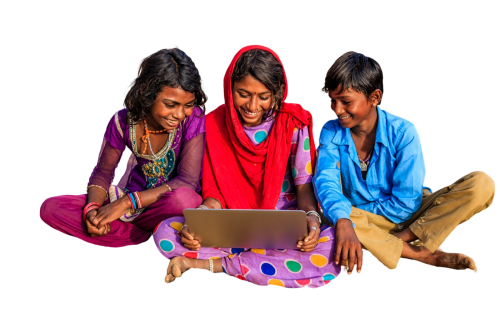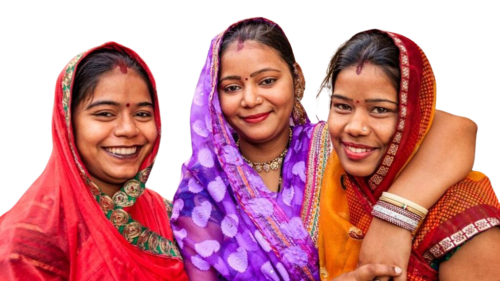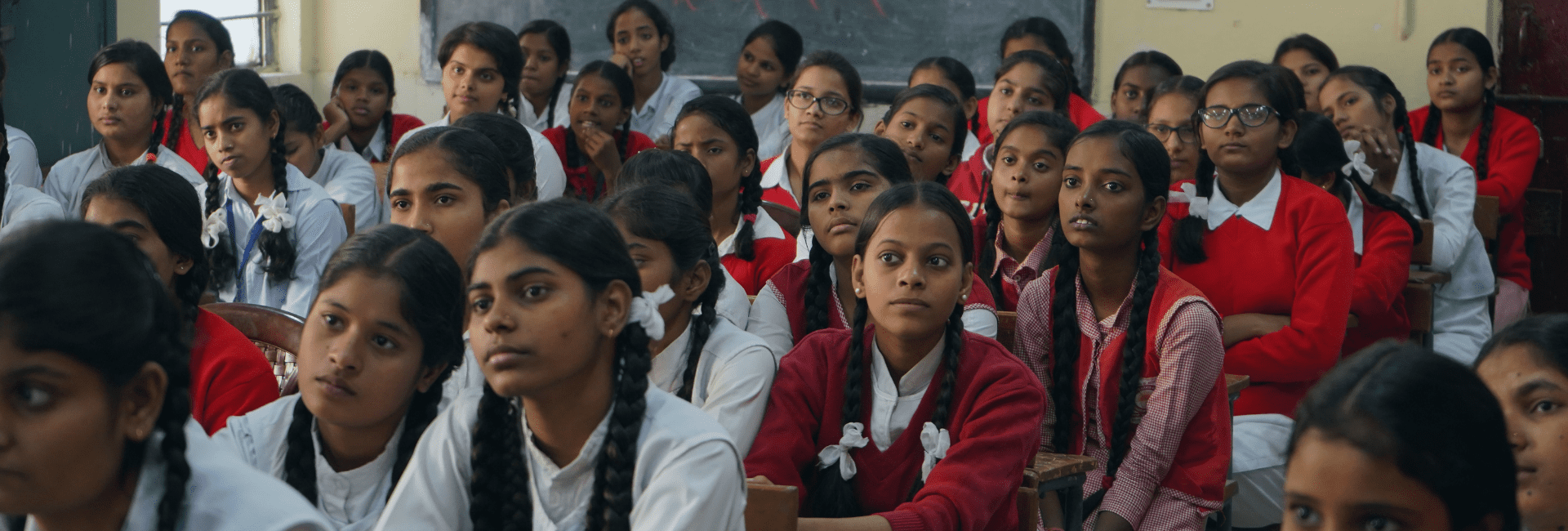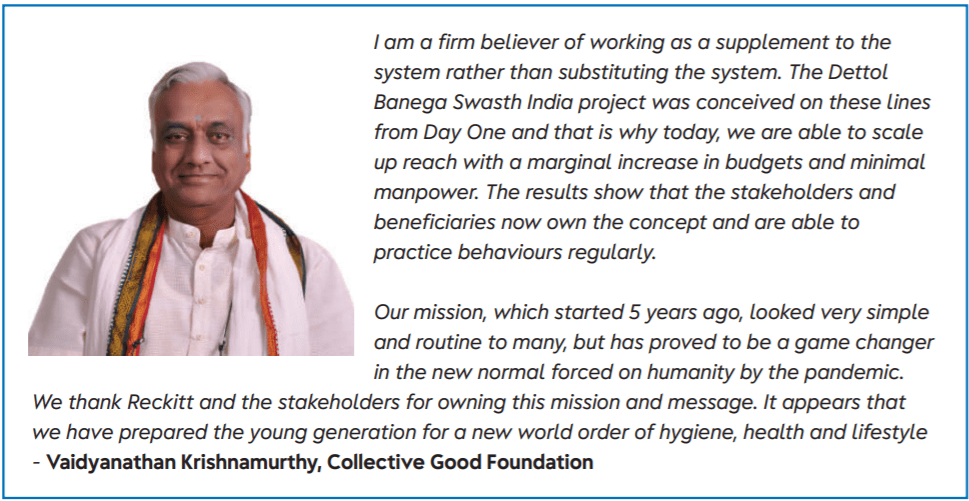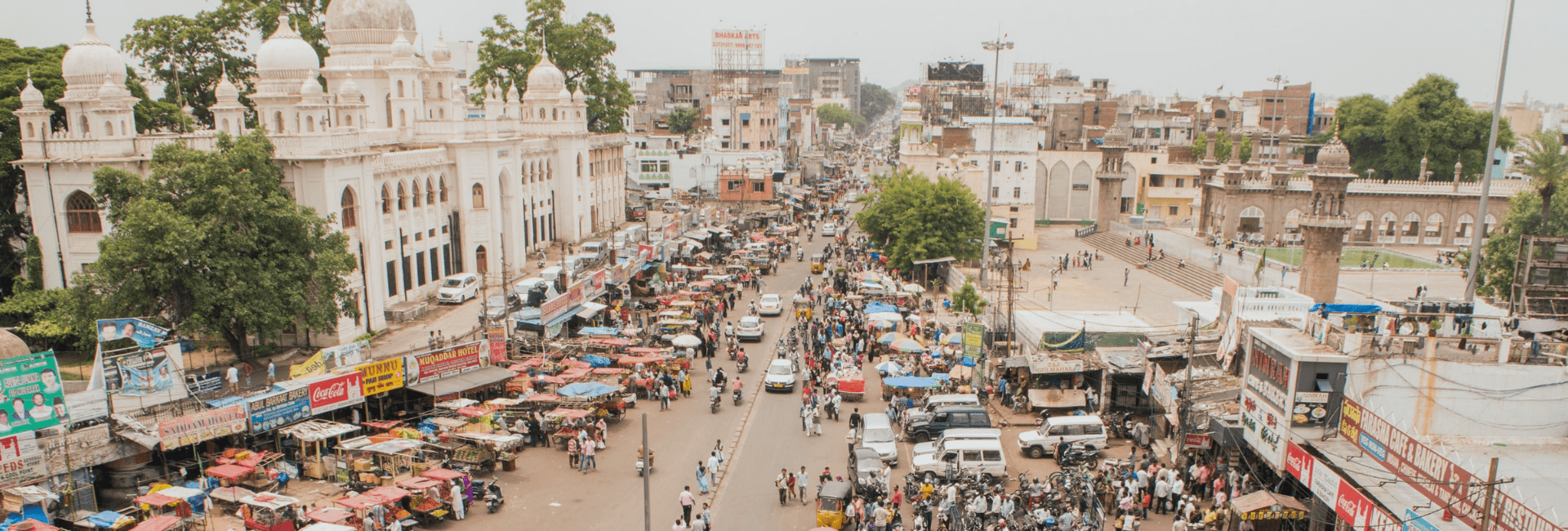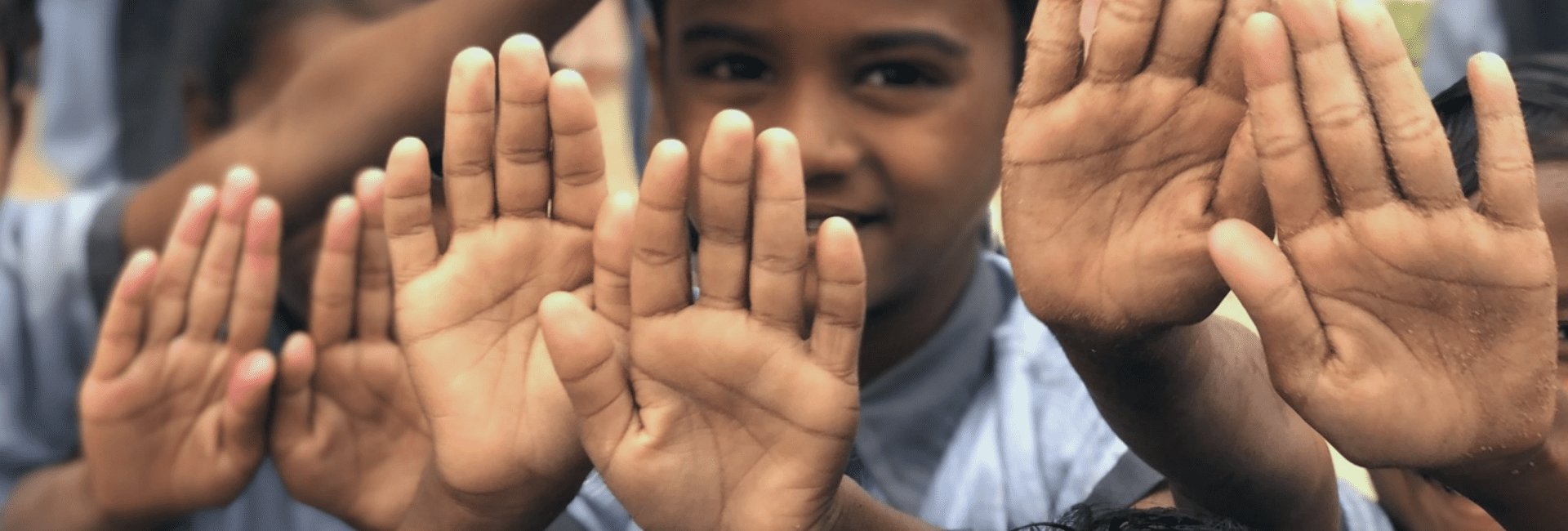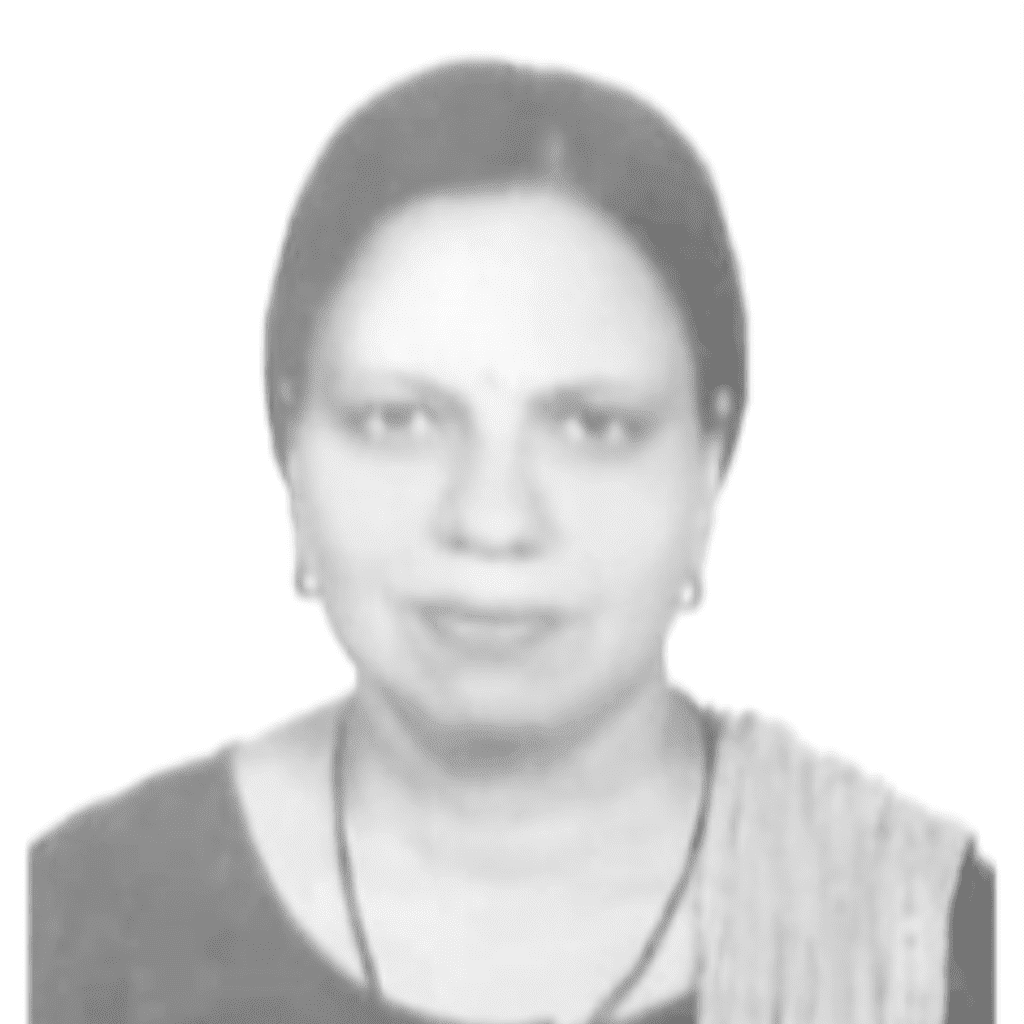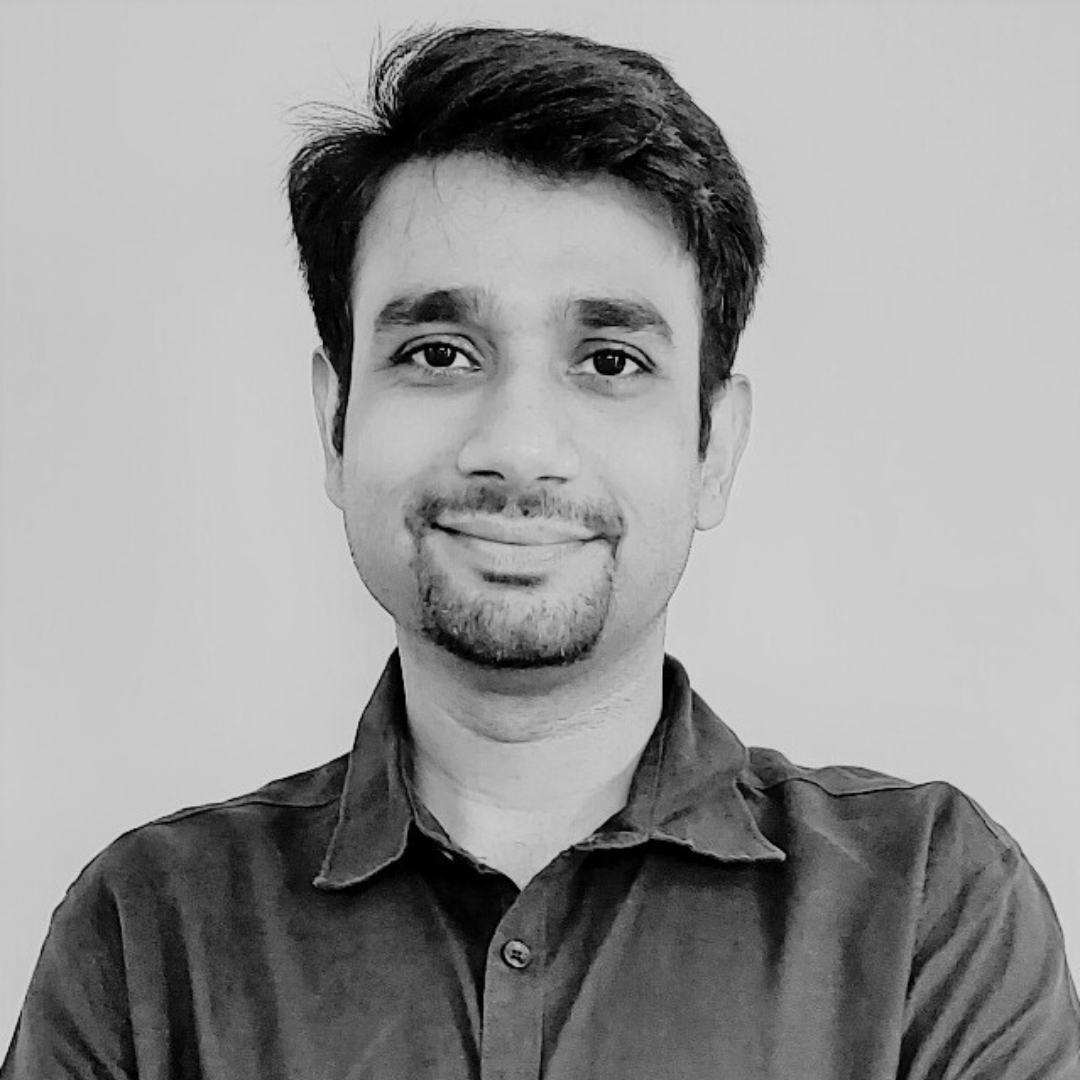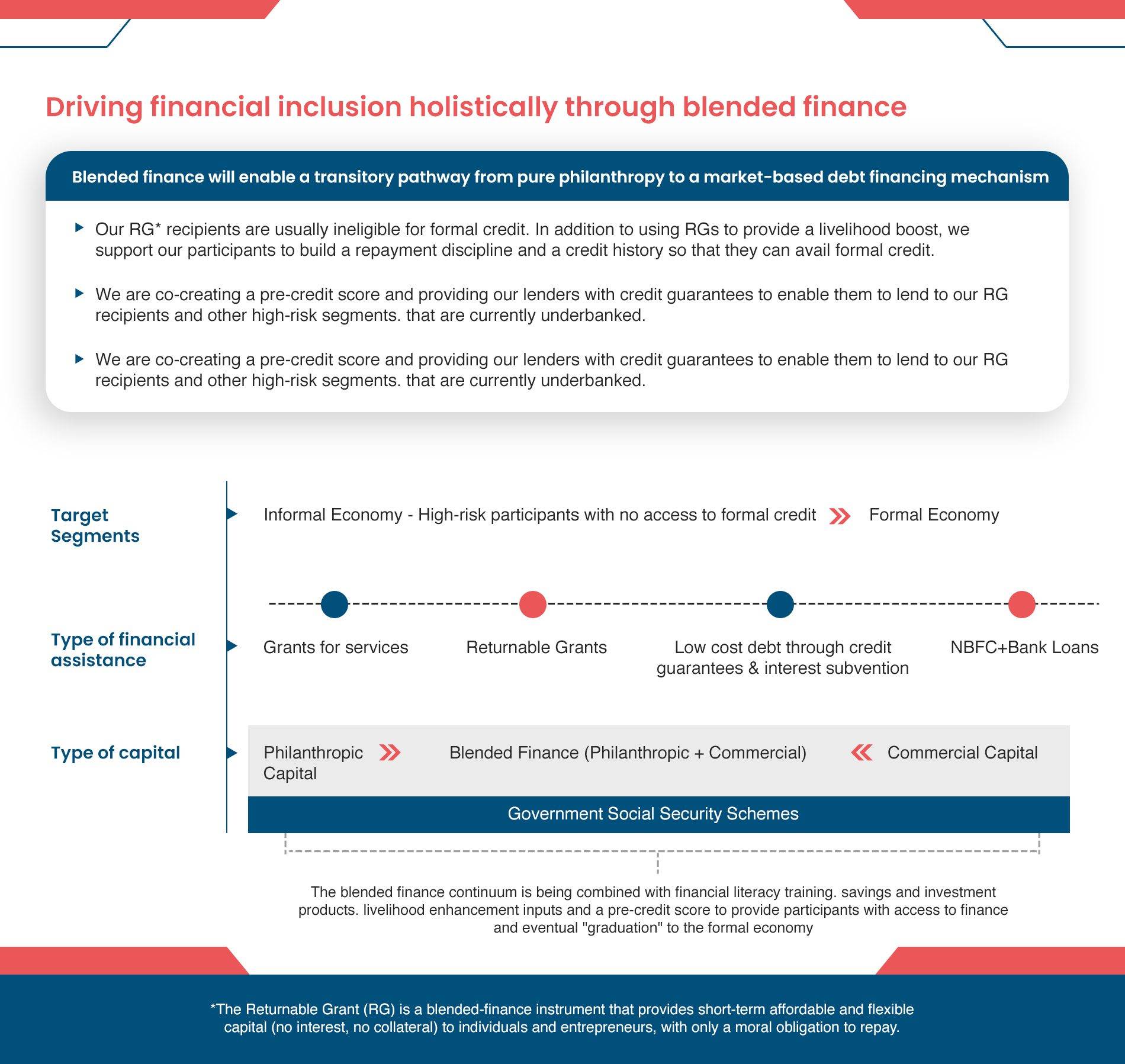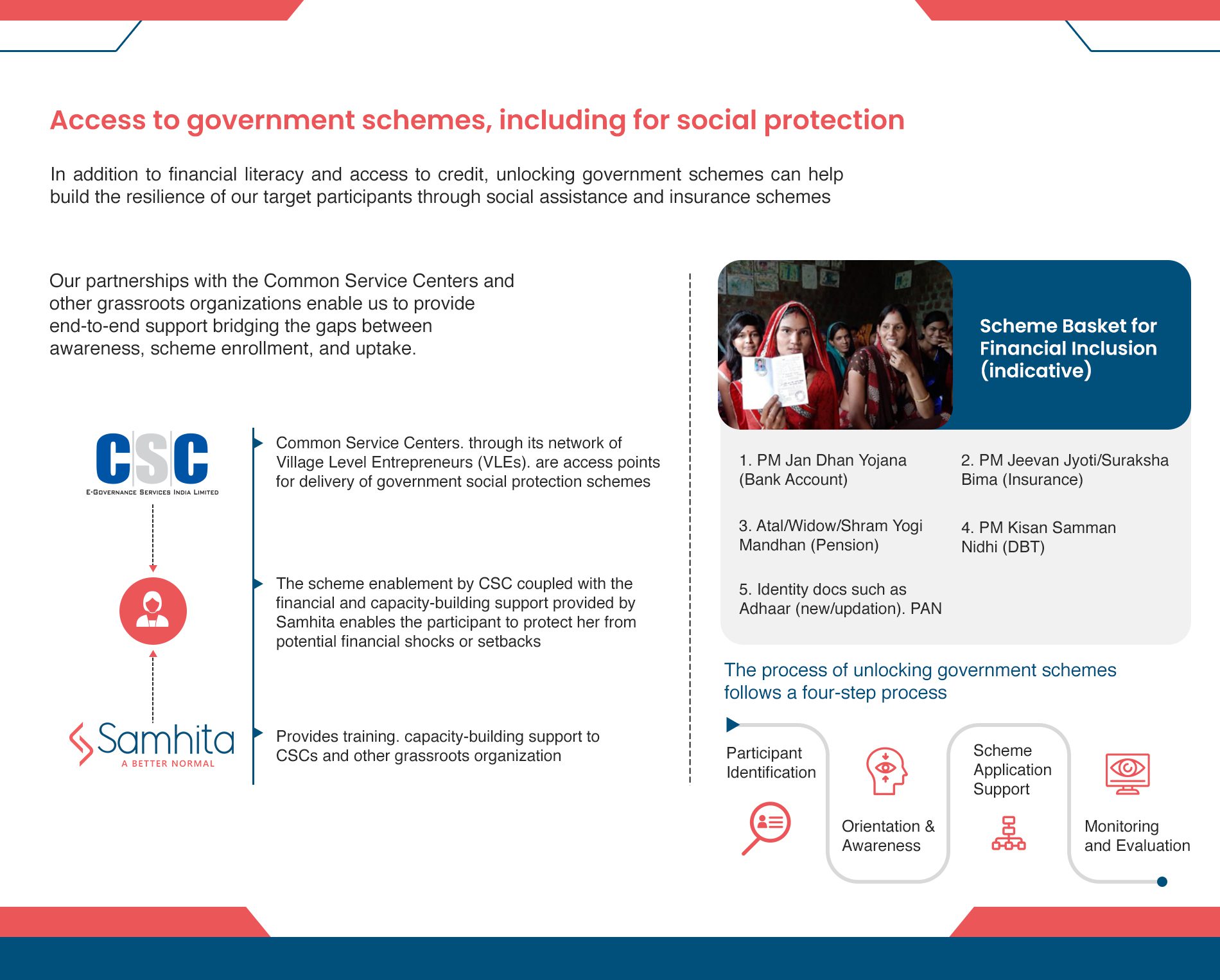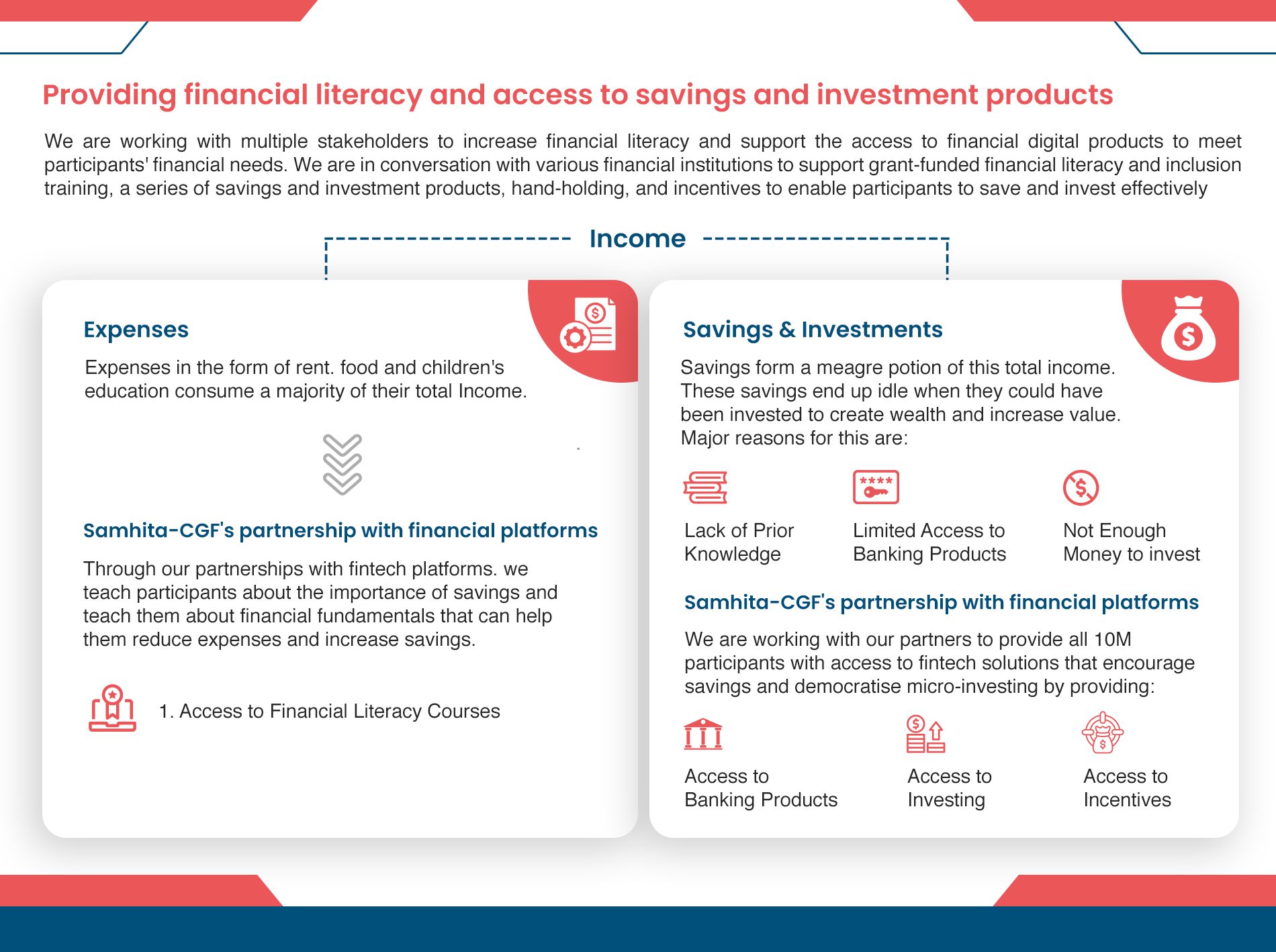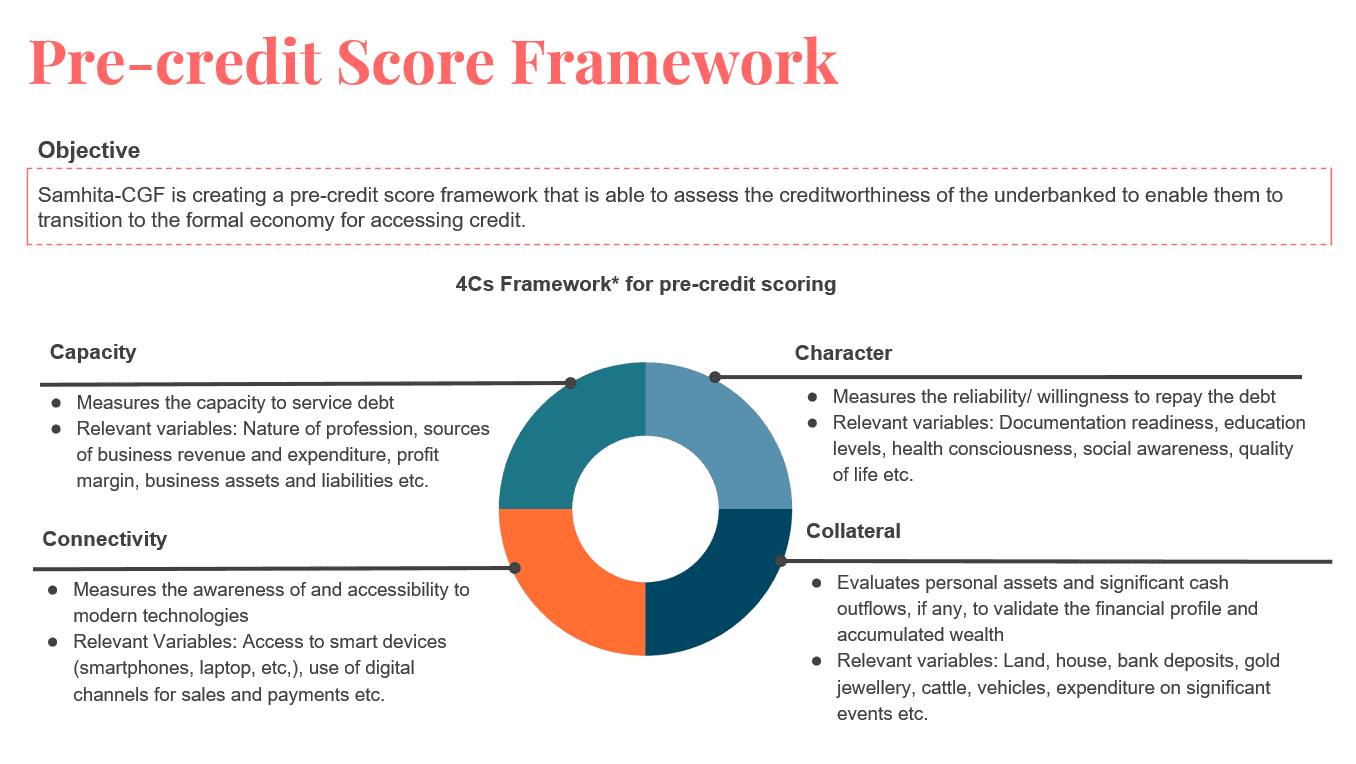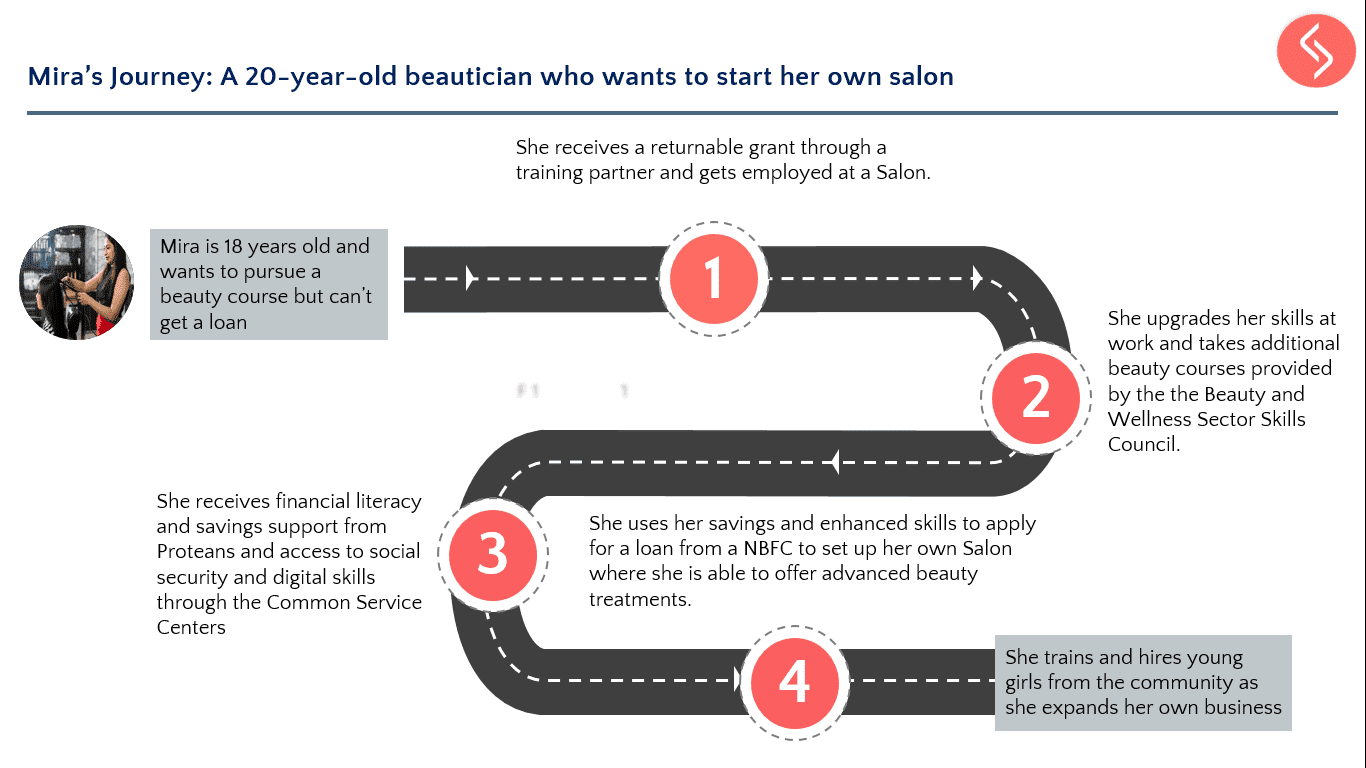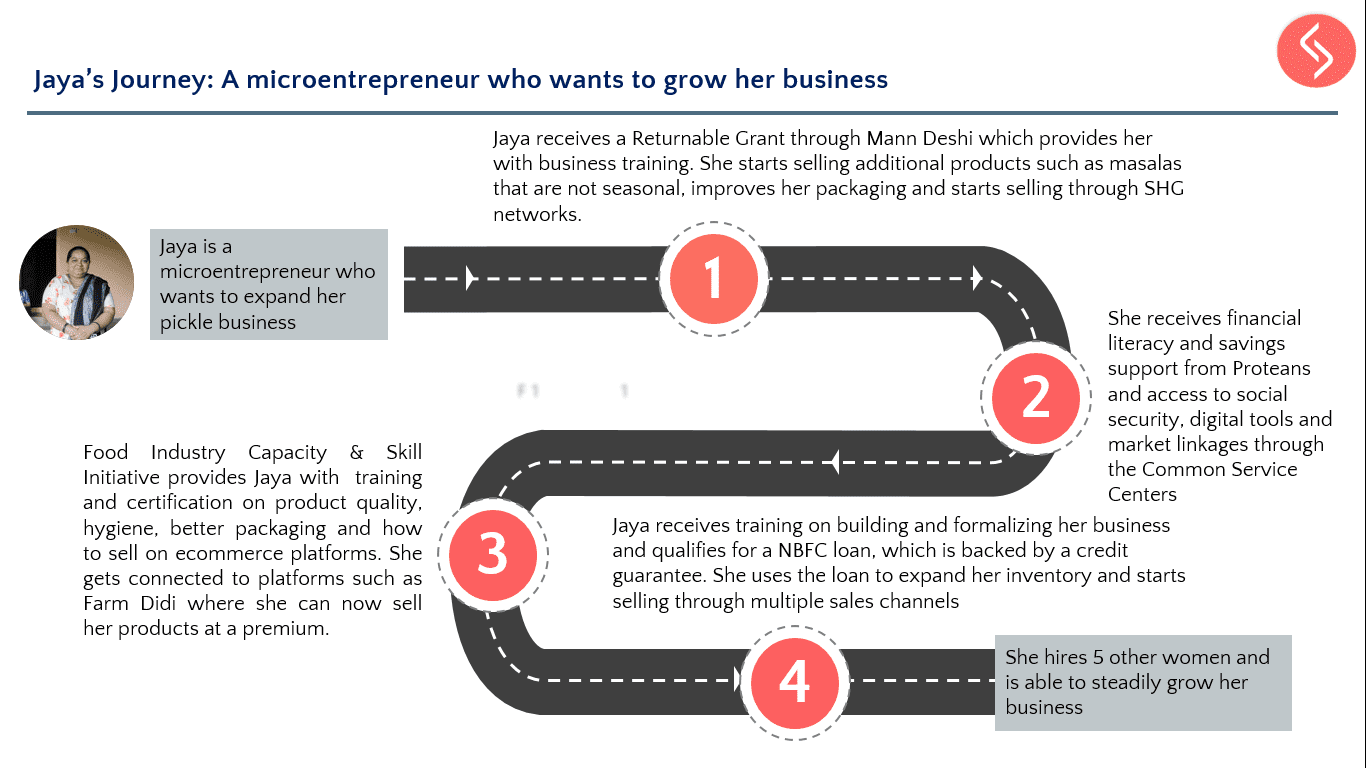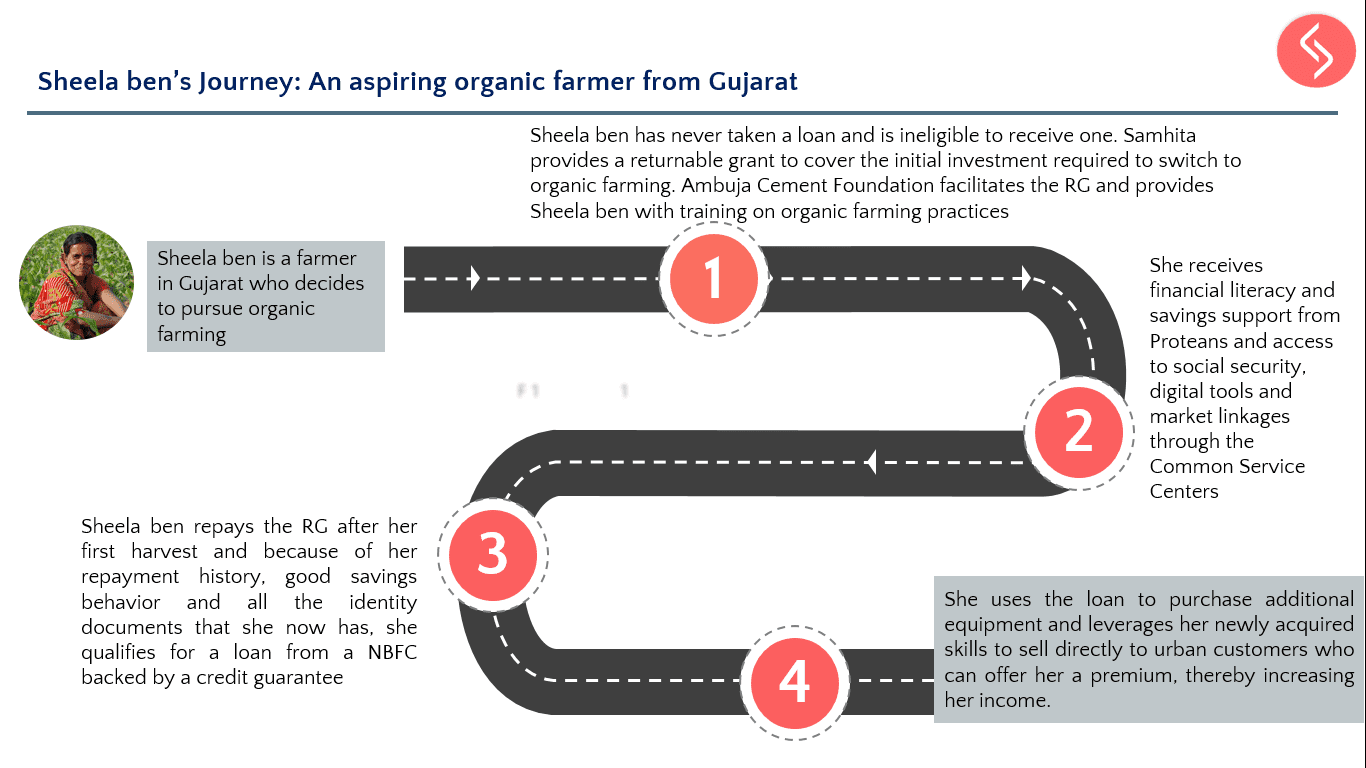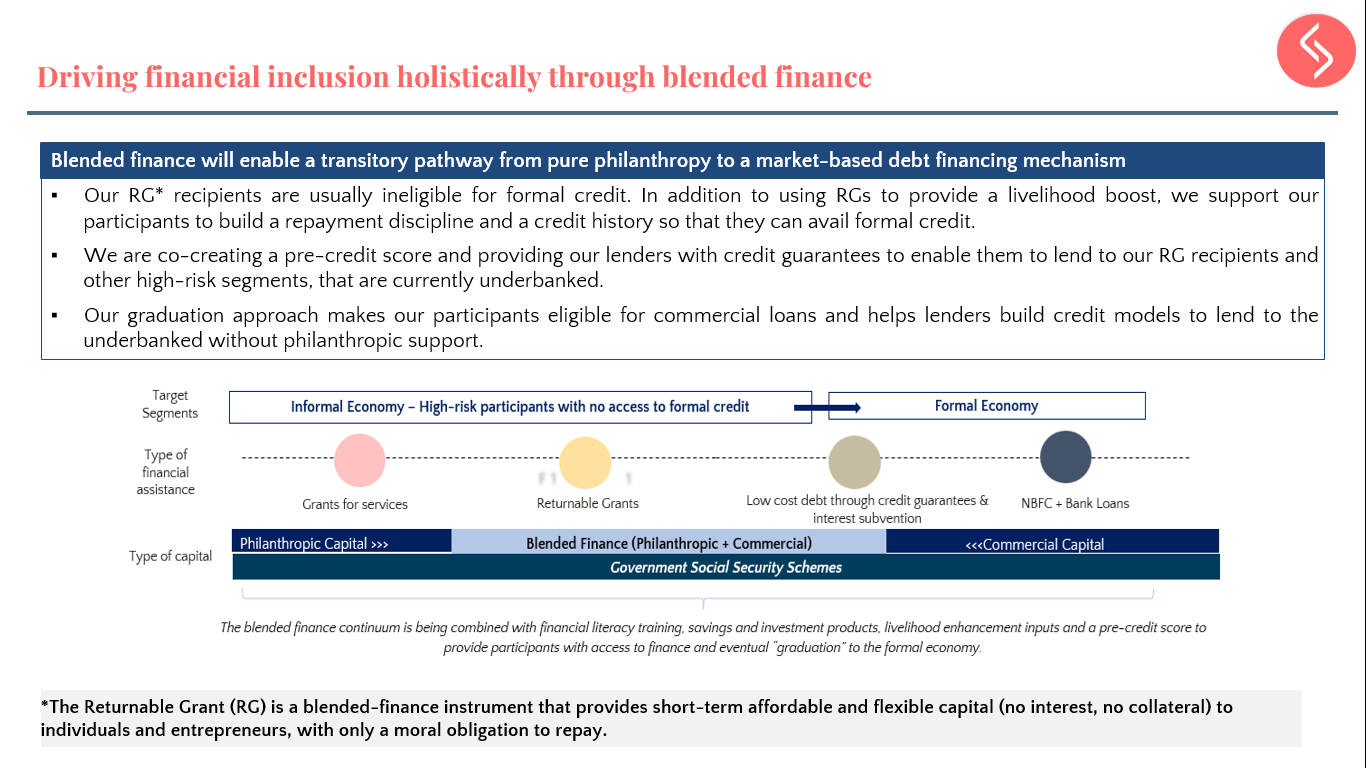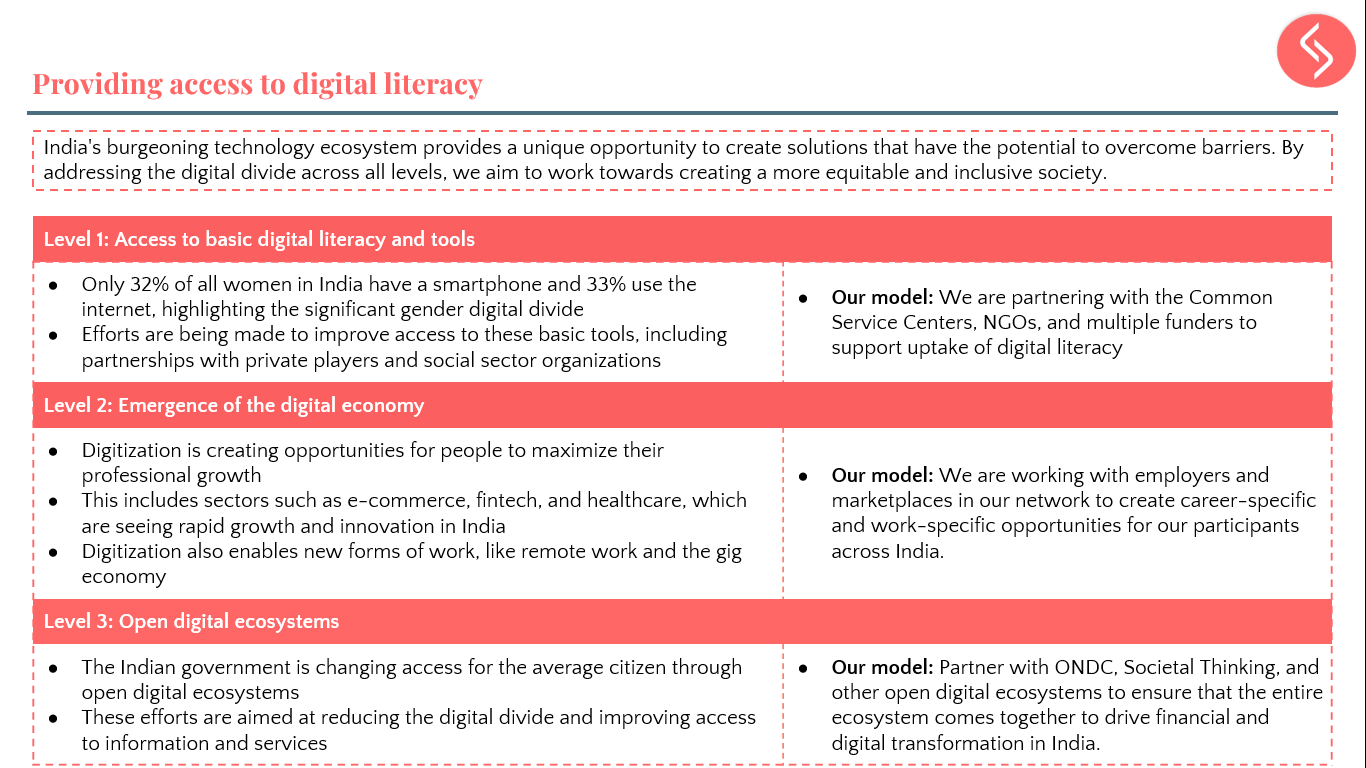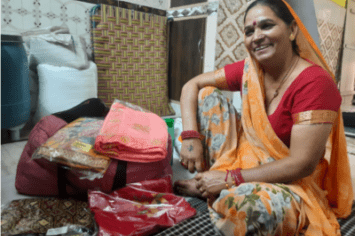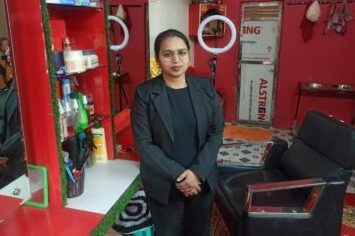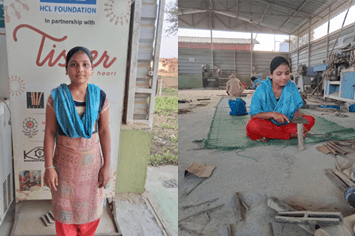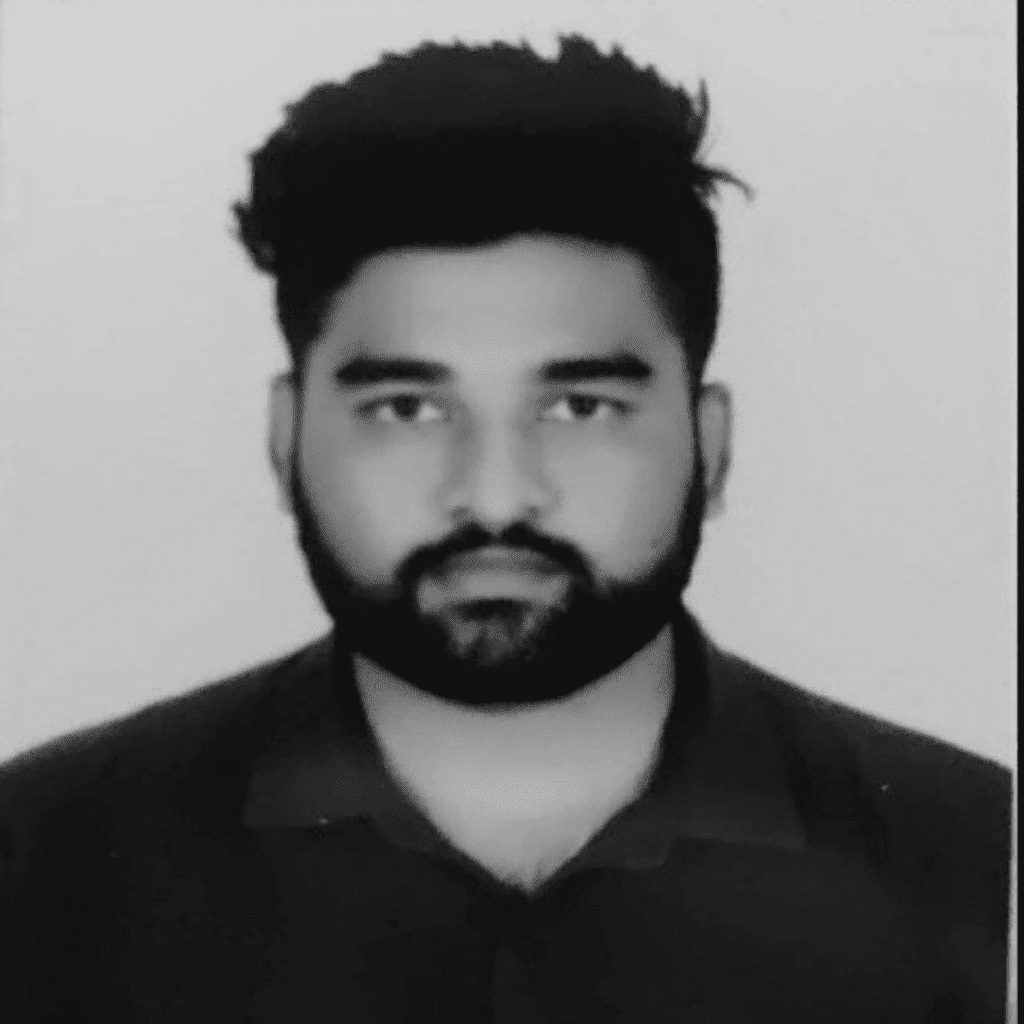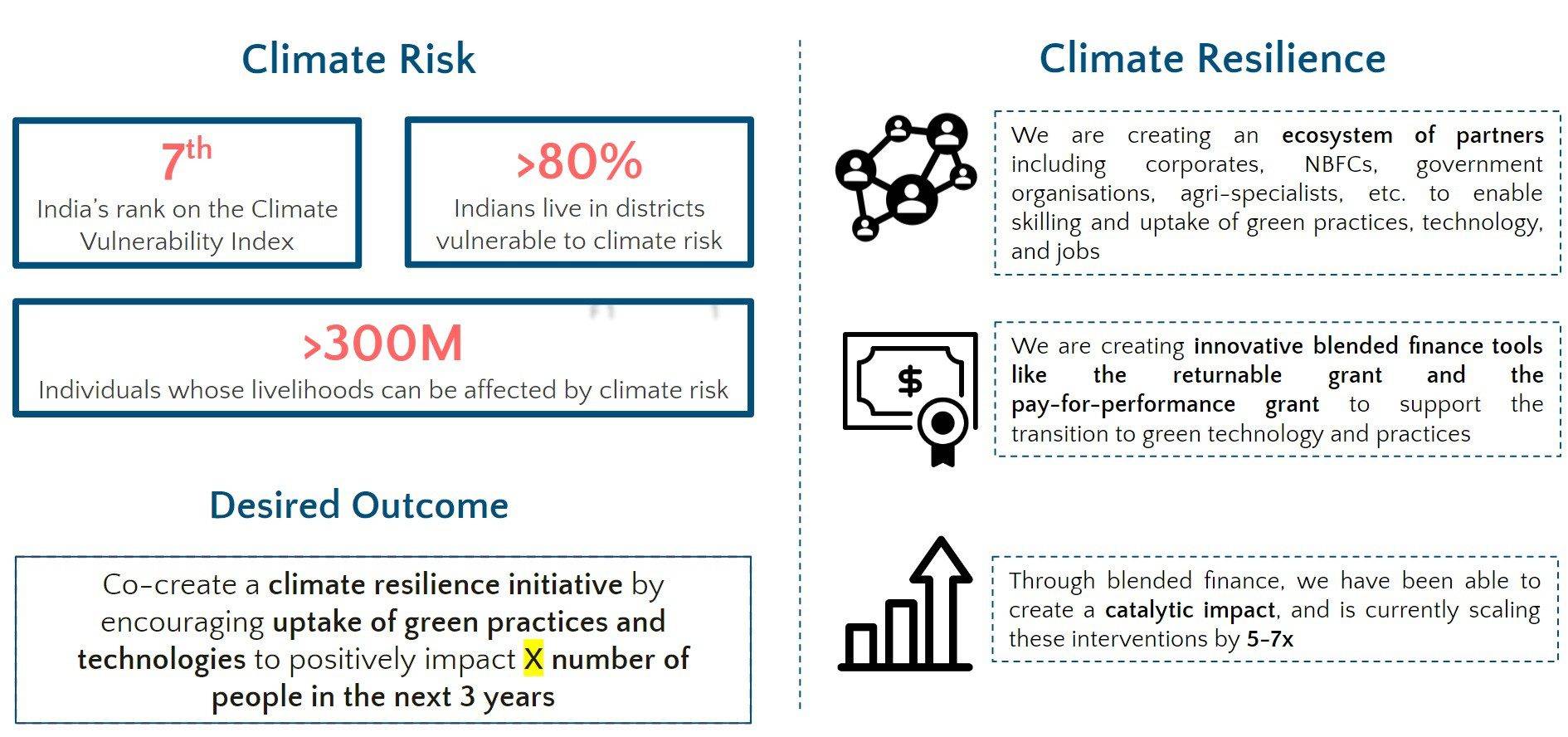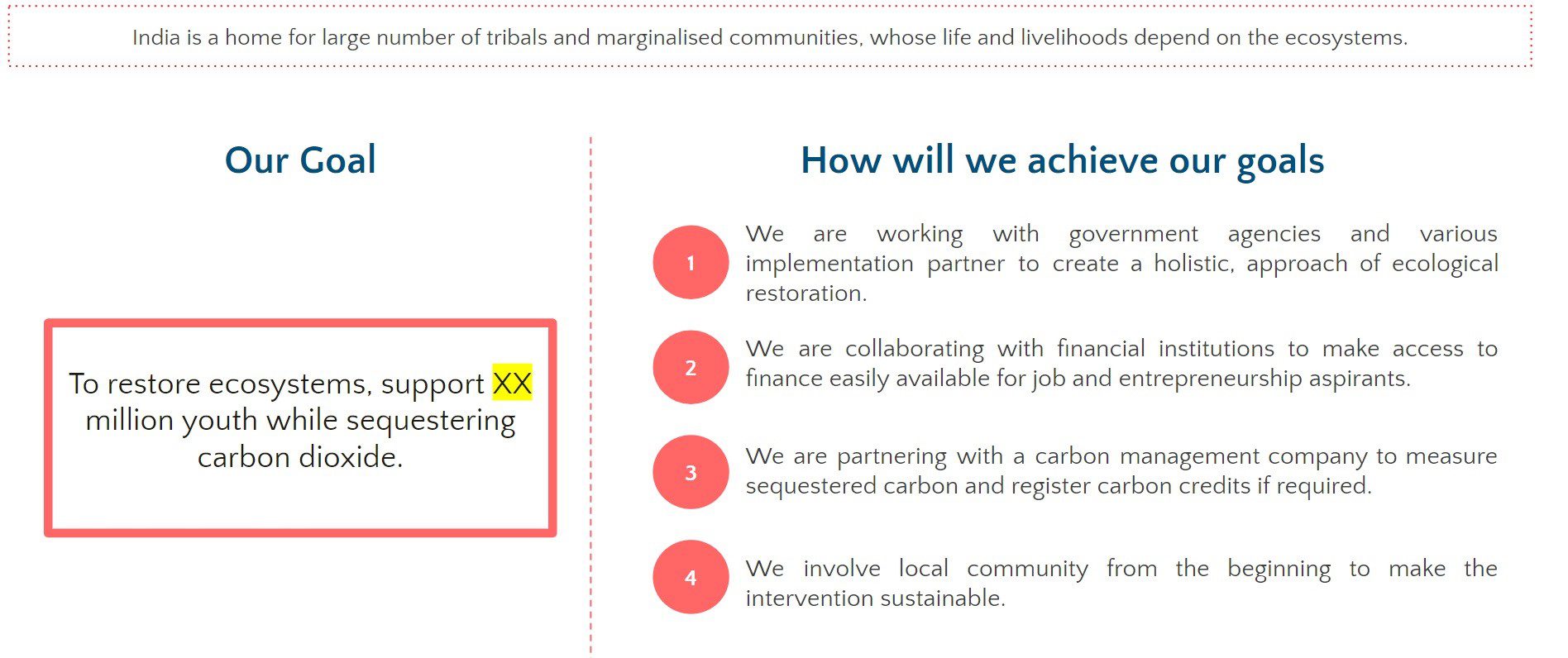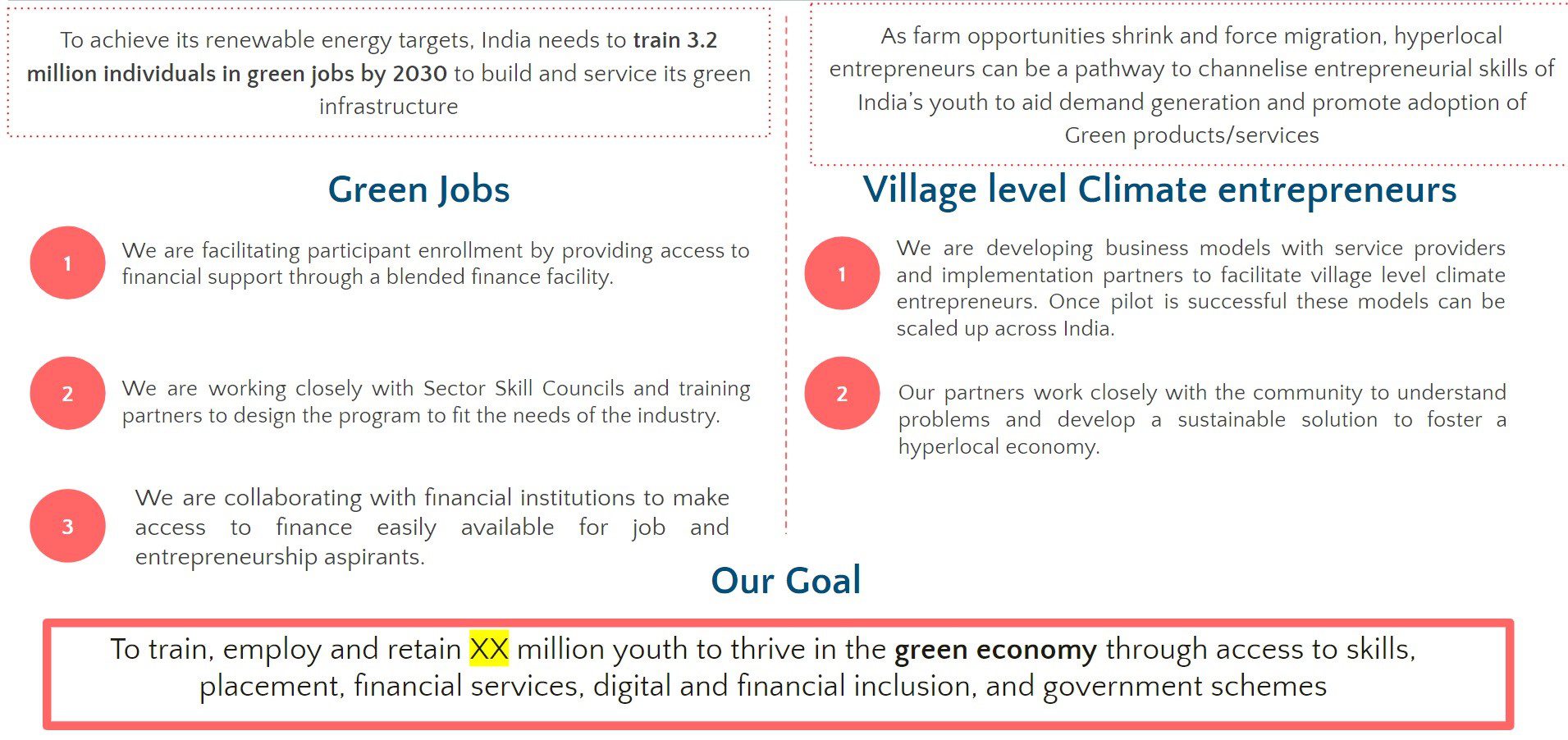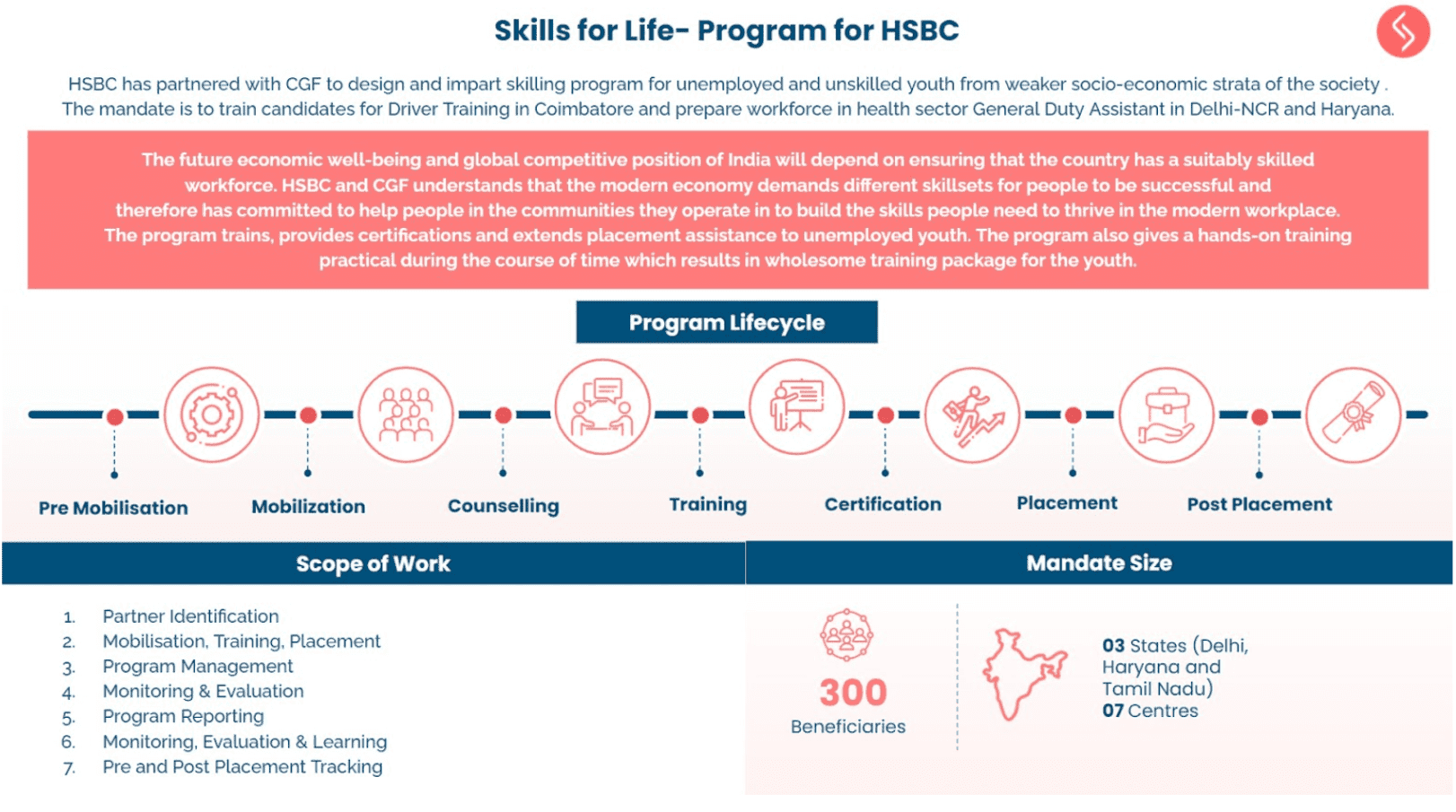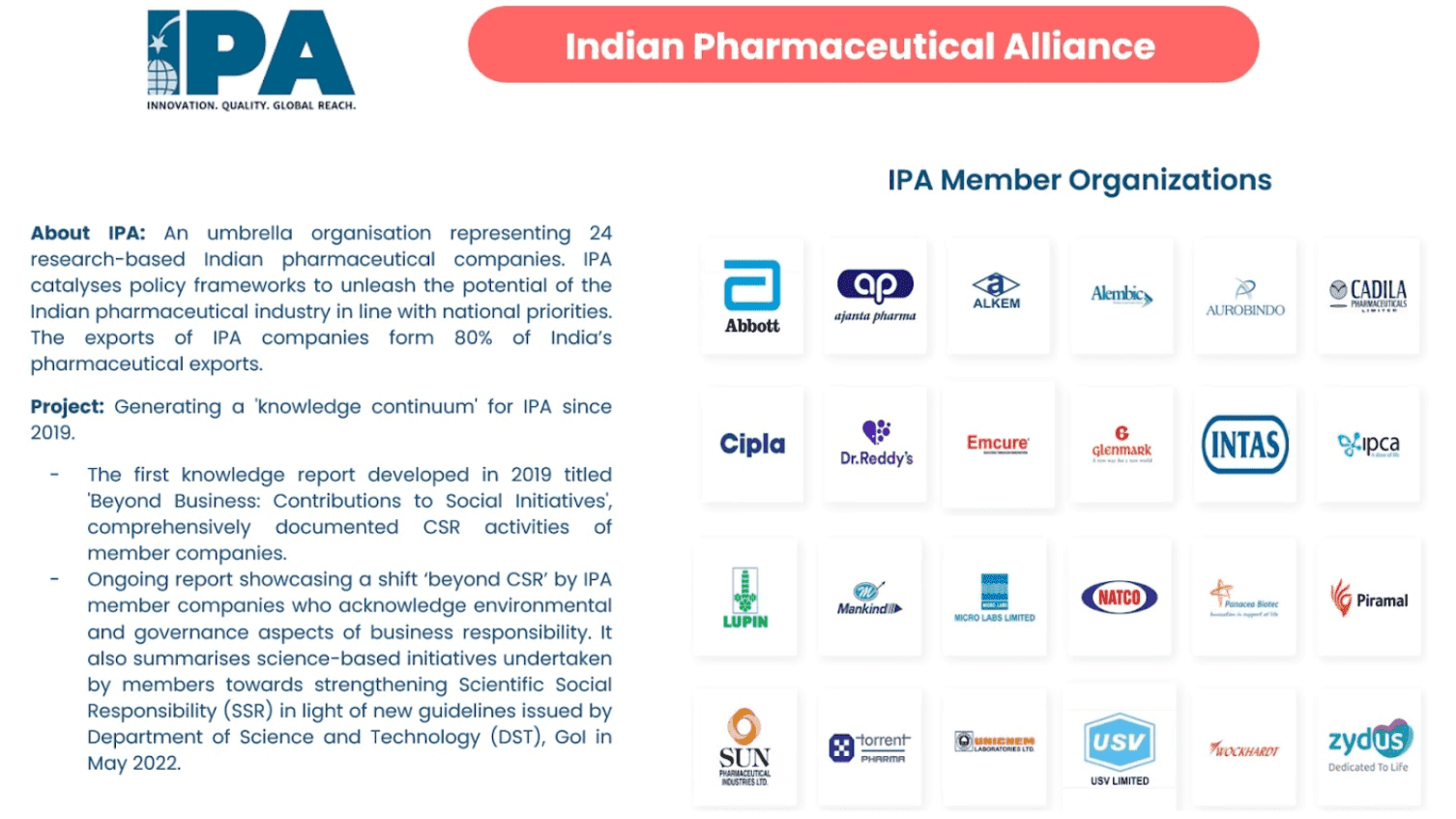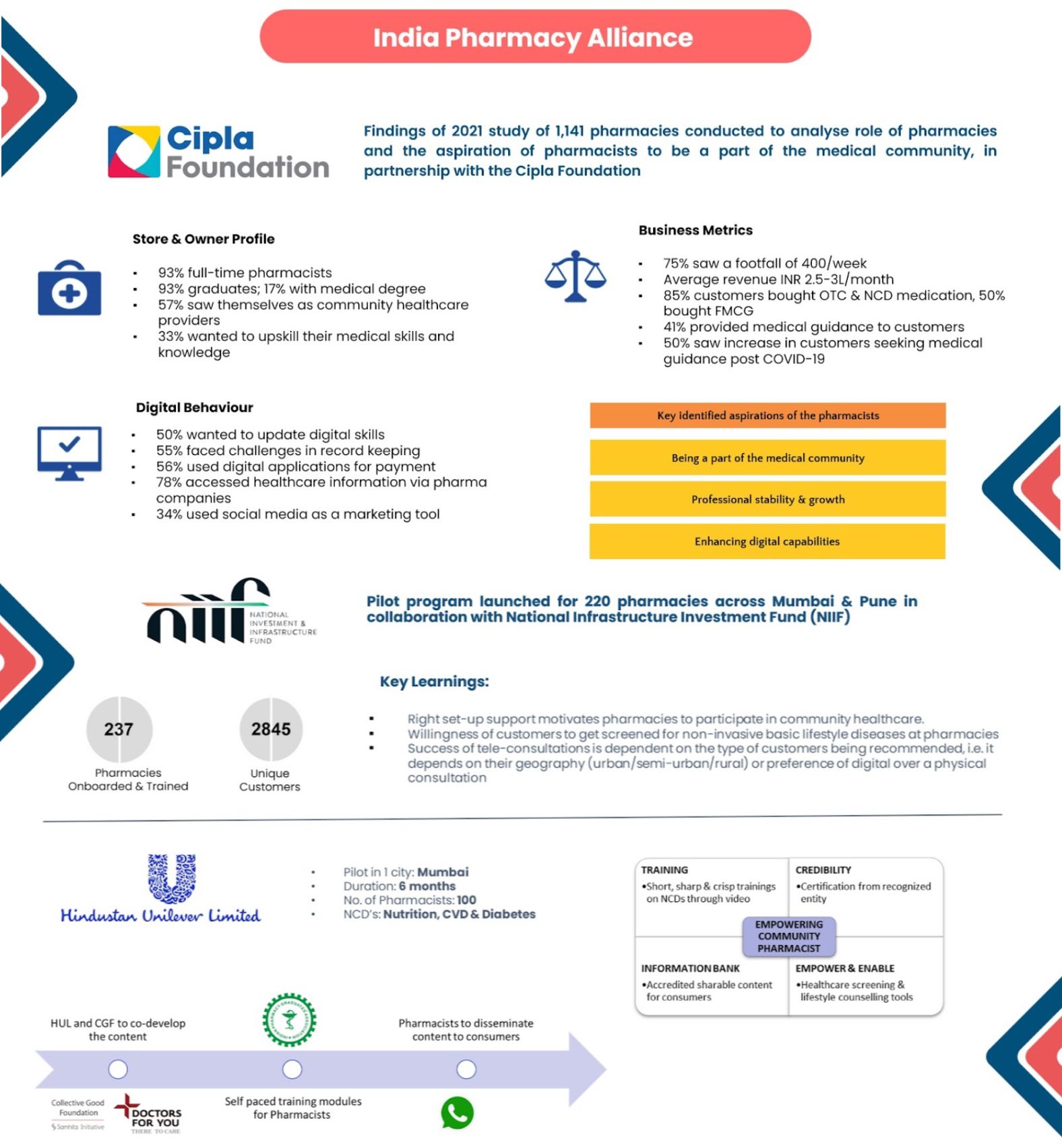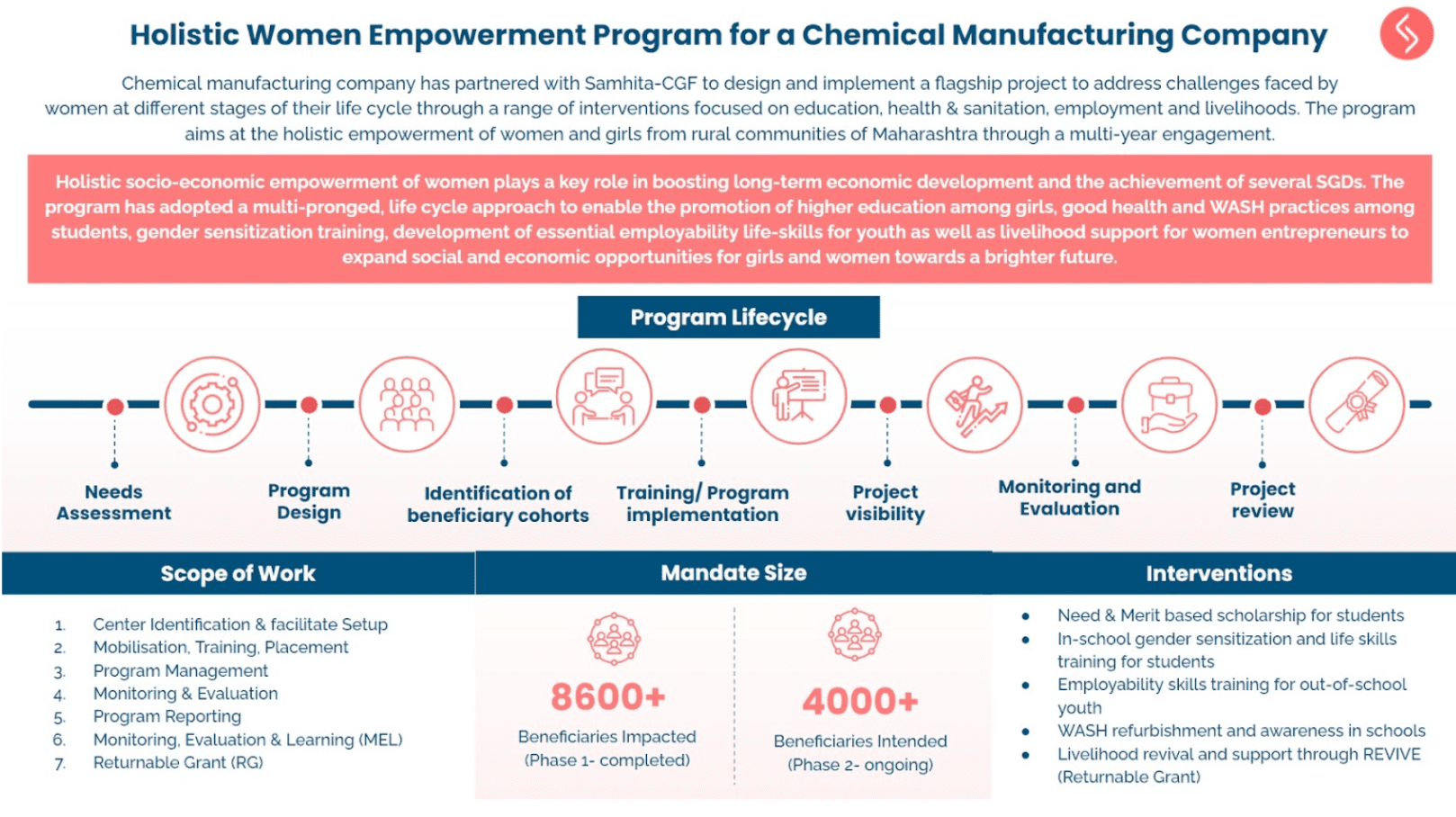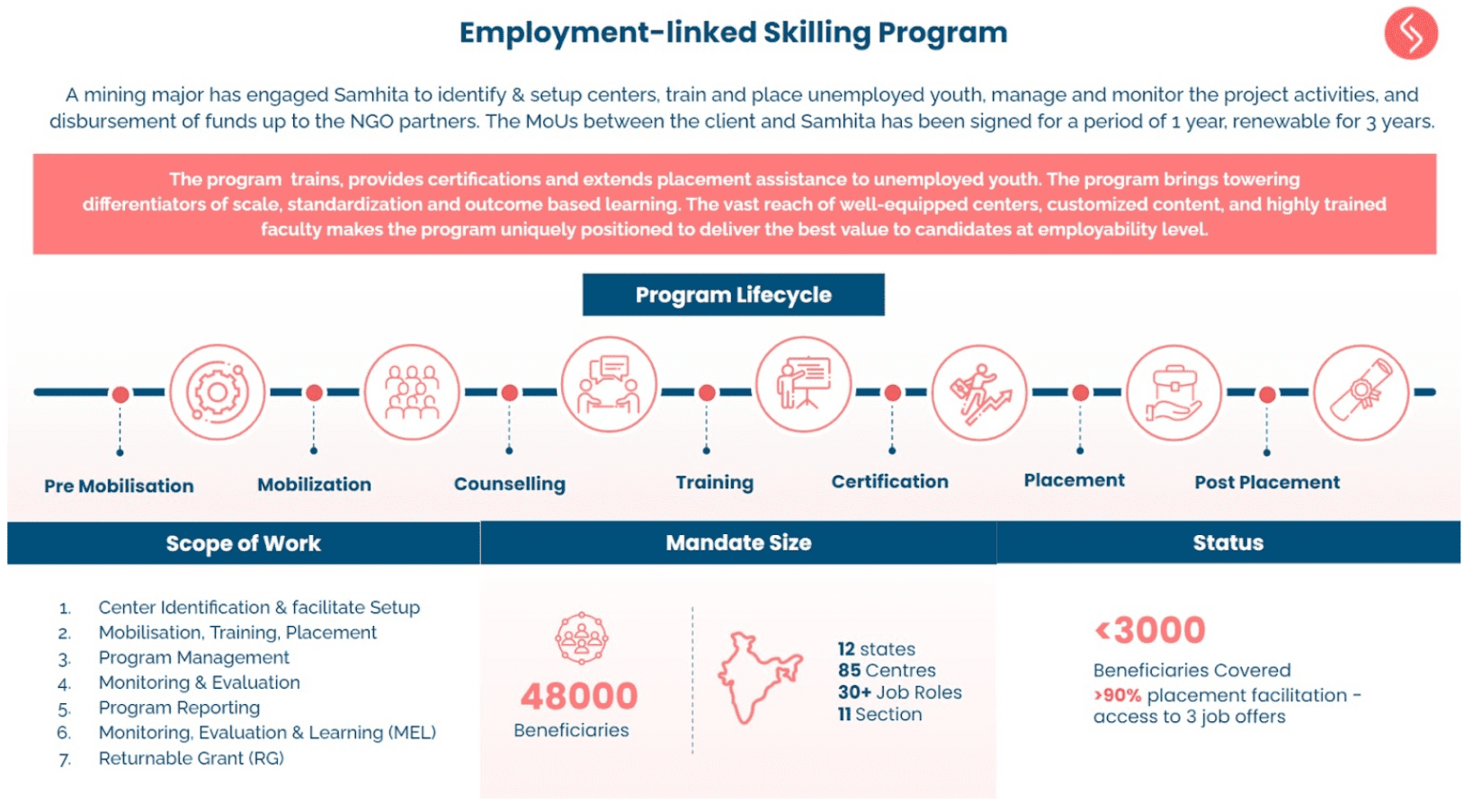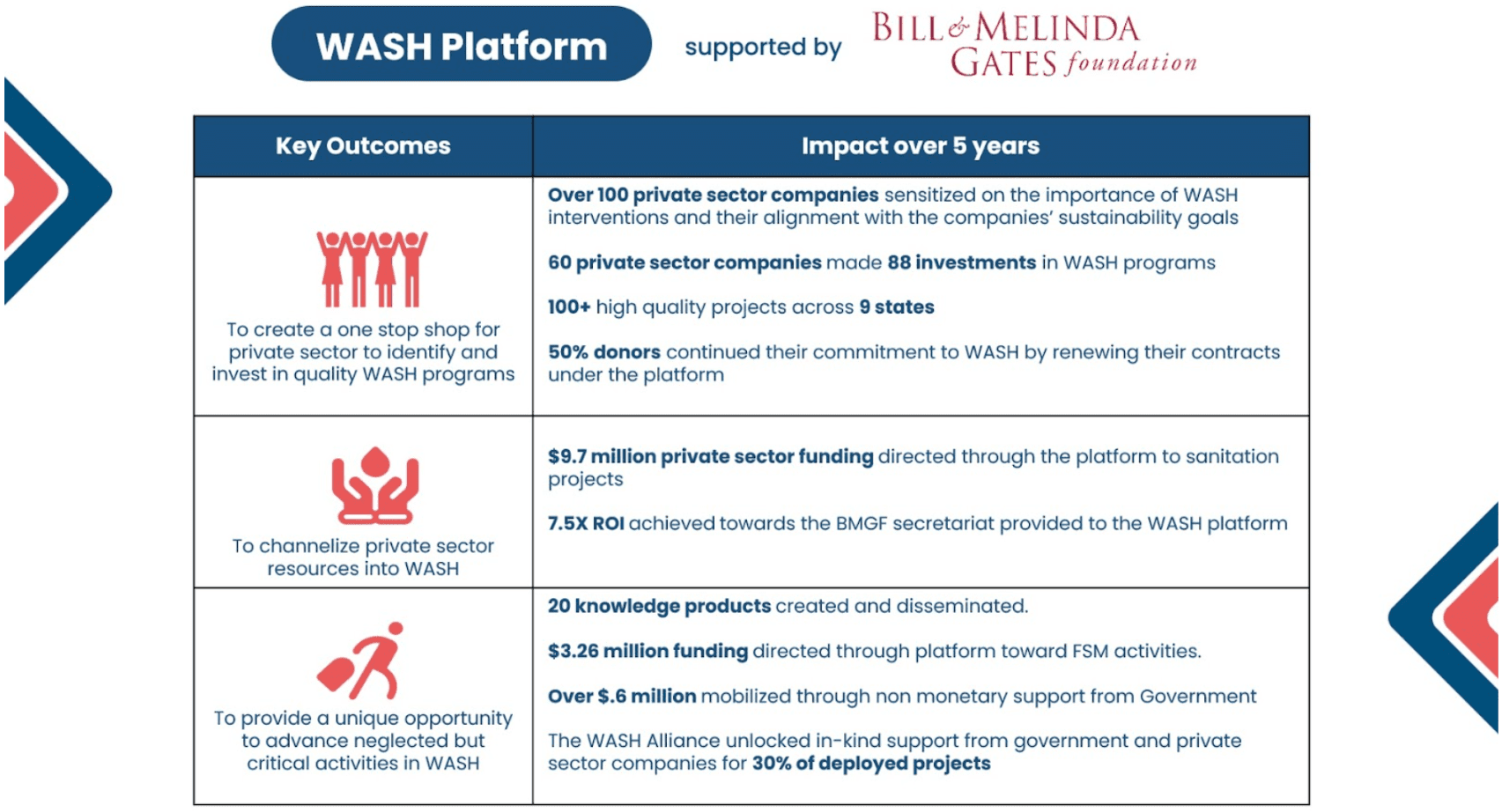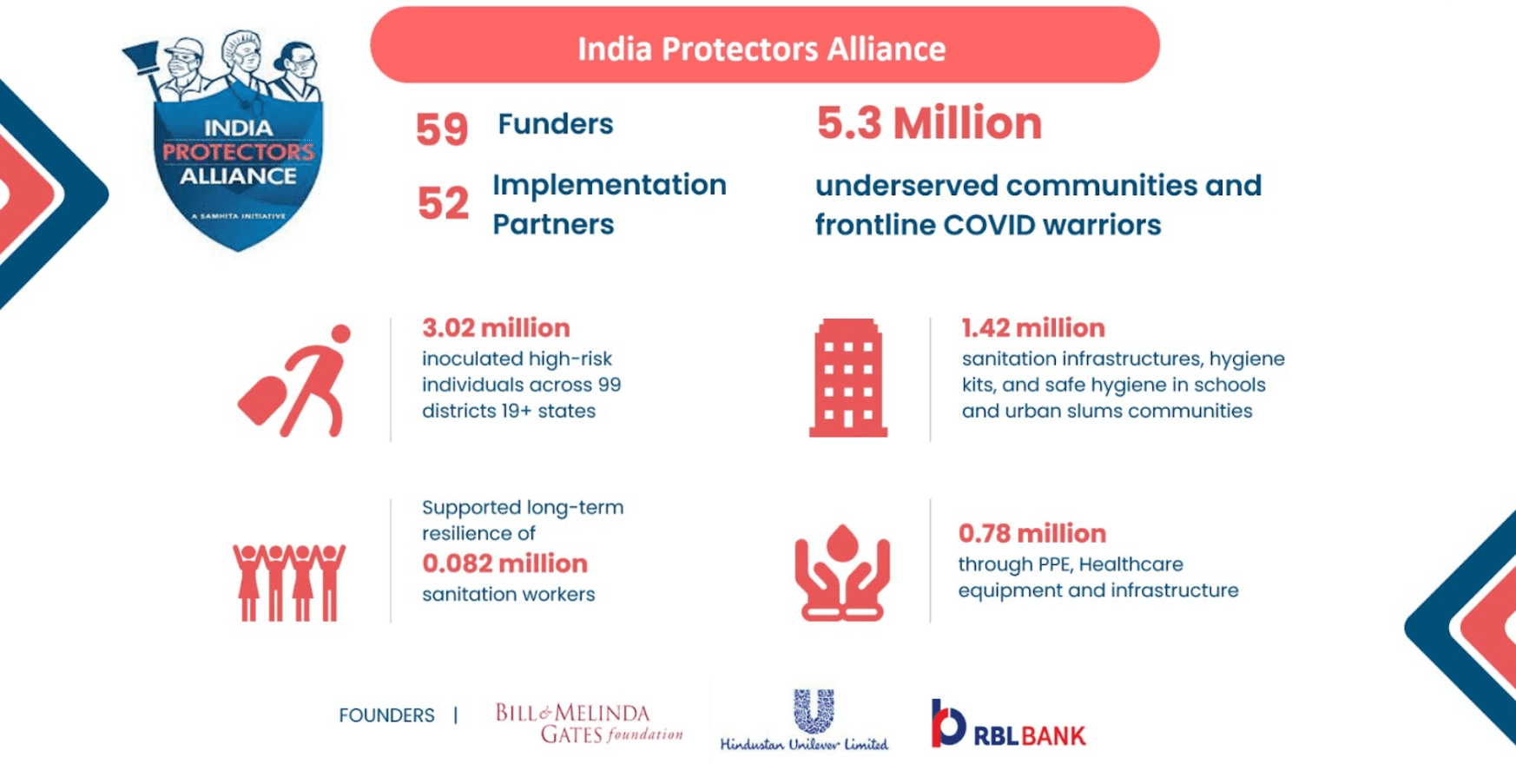DHFL|How to explore potential and unlock demographic advantage
DHFL|How to explore potential and unlock demographic advantage
DHFL wanted to invest their CSR funds in such a way that they can address critical gaps in 3 cause areas that can in turn help India unlock demographic advantages and explore the full potential of available resources. Read on to find out how they impacted over 150,000 lives.
The DHFL Story
Operating with a vision to engage in programs that can promote the enrichment of the society, DHFL first identified 3 cause areas and then worked with Samhita to curate or redesign programs that can address critical issues across the areas.
How to reap demographic advantages
Although India houses a high proportion of the world’s youth population, it has very few job opportunities and even fewer for those who are unskilled. Our research at the time indicated that the Indian government was able to train only 3.1 million of 12.8 million entrants into the workforce each year and needed private sector participation to address the gap.
Solution
We leveraged our research into corporate engagement in national skill development to design a skill program for youth within the Banking, Financial Services and Insurance (BFSI) and Construction sectors – that aligned to DHFL’s business goals.

Samhita managed the implementation of the program in 24 centres across 6 states. Inclusion of innovative components led us to receive recognition from the Associated Chambers of Commerce and Industry of India (ASSOCHAM), at their ASSOCHAM Summit-cum-Awards.
Geographies
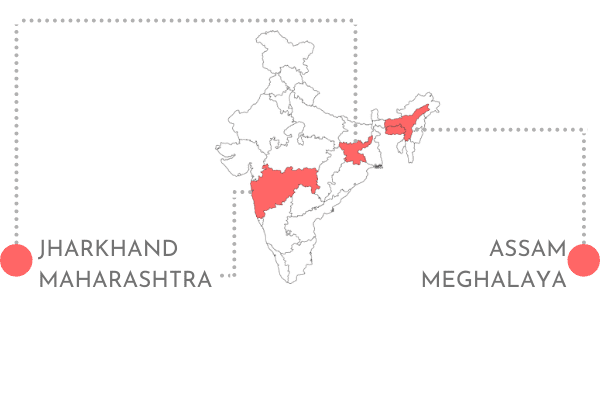
Impact
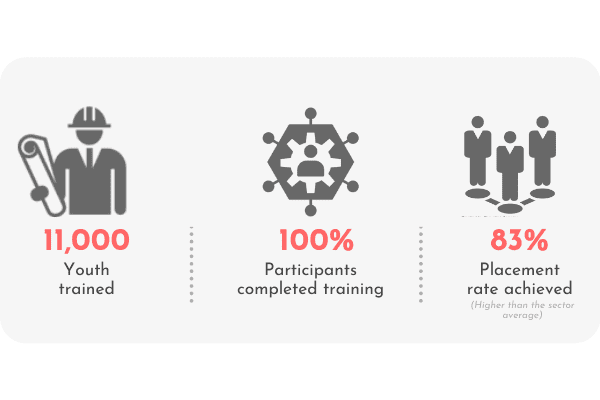
How to ensure early-life development
DHFL was already supporting smaller and scattered interventions in education however a focused program was not yet curated. At the time a focus on Early Childhood Care and Education (ECCE) programs was the need of the hour.
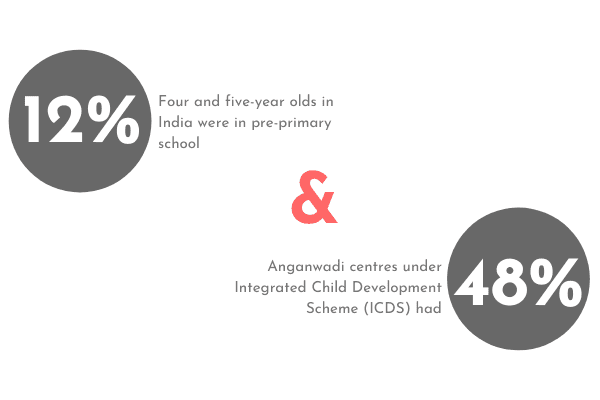
Solution
We first undertook an assessment of the Anganwadis to understand specific needs of the target groups and gaps in ECCE. Then we curated a program that strengthened existing Anganwadi frameworks and ICDS schemes, and built capacities of the workers and helpers to become educators in Anganwadi centres. We also added a health and nutrition component to complement the education module and to ensure the sustained success of the program in the long run.
Geographies

Impact

How to tap into the society’s potential to transform
The water crisis is not new to India. Moreover, the unavailability of water can have a rippling effect on lives and livelihoods. Even in 2011, our research lended insights into how climate change and successive years of drought had resulted in immense ecological damage including soil erosion, lack of vegetation and reduction in crop yield by 70 per cent. In order to ensure holistic development, it was necessary to invest in water as an impact multiplier.
Solution
5 drought prone villages in Aurangabad were identified and adopted where climate change and successive years of drought had resulted in immense ecological damage. This severely hampered the ability of the villagers to support themselves and their dependents.To holistically address the damage, we took a 5-pronged approach.
Impact

Impact across the People-Planet-Profit (PPP) framework

Youth of India are trained to unlock job opportunities for them; Proper nourishment is ensured to women and young children to enable long-term health and survival; Holistic development of community is propelled by using water as an impact multiplier.
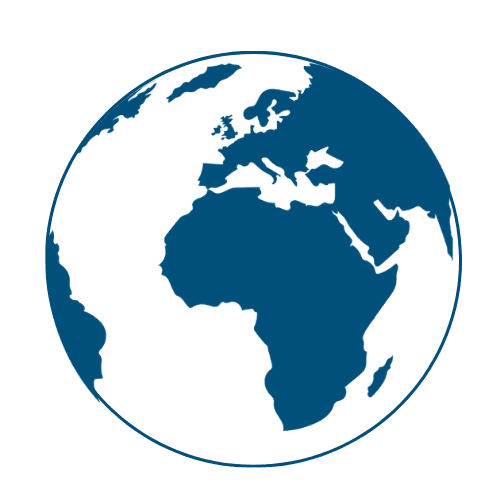
Community involvement prioritized to undertake water conservation and instill the component for the long term.

Supply of skilled personnel for the Banking, Financial Services and Insurance (BFSI) and Construction sectors – the primary
VIACOM18 | How to impact through the media lens
VIACOM18 | How to impact through the media lens
In a time where majority stakeholders were concentrating on building infrastructure to achieve the mission of Swachh Bharat Abhiyan, Viacom18 utilized the weapon they knew best – storytelling to create lasting impact in a society that has long been captured by the screen.
The Viacom18 story
With the launch of Swachh Bharat Mission, availability and access to toilets had improved tremendously. But social and behavioural change communication were far from implementation questioning the long-term adoption of infrastructure usage. Lack of sanitation has many rippling effects.

The economic deprivation increases manifold when healthcare expenses and the cost of lost potential due to sickness arising from inadequate sanitation is added.
With the belief that sustained change in behaviour is at the helm of creating long term impact, Viacom18 worked with Samhita to design an intervention that aimed to address the issue of Open Defecation in Mumbai’s slums and inadequate sanitation in schools.
How did we impact 8,000+ lives
Samhita designed and implemented a community sanitation program with a focus on strong behaviour change in addition to providing basic infrastructure. Our theory of change centered around changing behavior, beliefs, and myths around toilets as a key to ensuring sustained open defecation free status in all communities and schools. The idea was to design visual messaging at key locations in slum areas, followed with awareness campaigns that brought together a social message with Viacom’s unique panache for storytelling.
Our vision of multiplying the impact by evolving the approach from infrastructure to behavioral change was distributed in 3 stages.

Geography

Impact

Kimberly Clark | Making lives better through purpose driven brands
Kimberly Clark | Making lives better through purpose driven brands
The global effort to achieve sanitation and water for all by 2030 is extending beyond the household to include institutional settings such as separate washrooms in schools and workspaces.
About 94% of women are employed in the informal sectors, according to the National Women’s Commission. Such informal sectors lack basic sanitation facilities including toilets. Public toilets, even if available, are often unsanitary and poorly maintained. Without access to toilets, women and girls develop coping strategies like drinking less water that in turn increases the risk for women’s health problems and their well-being, especially in times of menstruation. The extent of the problem is large in the school ecosystem across India

With the mission to create better workplaces that are healthier, safer and more productive, KCP in partnership with Samhita, designed two projects-
- Provide improved sanitation infrastructure in rural schools in Maharashtra and nudge children to adopt better sanitation habits
- Provide increased access to better sanitation facilities for women working in informal markets
How did we impact 2000+ women and children’s lives
Project 1- The project aimed at solving two key challenges-
- Poor usage of toilets by children in schools, and
- Absence of hand washing facilities at critical junctures
We collaborated with the Swachh Maharashtra Grand Challenge, a first-of-its-kind open innovation platform, in partnership with the government, corporate & social sector to address the key challenges in the sanitation ecosystem; by identifying and piloting innovative programme models across sanitation value chain. We identified 4 major components under this setup-

How to address the school sanitation ecosystem
Project 1 – The project aimed at solving two key challenges –
- Poor usage of toilets by children in schools, and
- Absence of hand washing facilities at critical junctures
We received 50+ innovative solutions from across the country. A thorough review of the applications led us to select the most innovative and sustainable programs that would help build an impactful ecosystem in school sanitation. KCP and Samhita together set the journey from selection to knowledge dissemination for the selected programs:
- Providing grants to selected pilot programmes
- Coaching & mentoring
- Project monitoring & evaluation, and
- Knowledge dissemination.

The project impacted 2000+ children of Chandrapur, Maharashtra.
How to help women access sanitation in informal markets
The second project aimed at addressing the need for safe sanitation facilities for women working in informal markets. We shortlisted GARV TOILETS and CORO as implementation partners. The project provides sanitation facilities with following features:

To provide holistic, effective and sustainable sanitation impact, four components were designed:
- Localised Behaviour Change Communication
- Menstrual Hygiene Management
- Operations & Maintenance
- Waste Management
To support the end-to-end implementation of the project, Samhita leveraged their in-house expertise through the following stages- providing operational plans, developing standard operating procedures, monitoring and evaluation progress and outcomes and providing capacity building support for the implementation partners.
The project impacted 2000+ women in Kurla, Mumbai, Maharashtra.
Geographies
Project 1: Chandrapur Maharashtra
Project 2: Kurla, Mumbai, Maharashtra
Impact Numbers
4000+ Lives Touched
Reckitt Benckiser | How to leverage core competencies to create impact
Reckitt Benckiser | How to leverage core competencies to create impact
Urbanisation and climate change have led to an increase in the need for improved water, sanitation, and hygiene (WASH). While companies across India try to address the critical gaps in WASH through their CSR, RB decided to take a shared value approach and unlock advantages for both business and society.
The Reckitt Benckiser Story
Children spend a significant portion of their day at school where WASH services (including access to drinking water, sanitation and hygiene) can impact student learning, health and dignity particularly for girls. Most water and sanitation related diseases can only be prevented by improving a number of hygiene infrastructure and behaviours.

With a view to harness the potential of India’s next generation to become sanitation change leaders, RB and Samhita designed an intervention which recognizes the role of children as key drivers of change and arms them with the right tools to drive change as well as collaborated with the government to scale the impact.
How did we impact 1 lakh students
Samhita designed a program with a focus on driving behavior change through community ownership and advocacy at the level of government and the school administration, in addition to imparting education on hygiene practices among children. Our approach to multiply the impact was two fold:

This project has adopted the proven route of community engagement to reach thousands of lives. The Behavioural Change Communication (BCC) plan covers not only hand washing but also the importance of personal and environmental hygiene practices. Wall paintings, celebration of important international and national events related to WASH were observed in large scale in the states. In addition, students and teachers engaged several community leaders and school management committees in their locations to spread awareness on best practices in the communities.
Geographies

Impact

India Protectors Alliance – Catalytic achievements with the support of HUL, BMGF and RBL Bank
India Protectors Alliance – Catalytic achievements with the support of HUL, BMGF and RBL Bank
Over the past two years, we have experienced a unique and unprecedented situation due to the COVID -19 outbreak and subsequent lockdowns. The multiplicity nature of COVID-19 needed an all-hands-on approach that saw corporates, philanthropists, civil societies, and individuals come together to support immediate relief efforts and save lives.
Corporate India and non-profit organisations’ response to the COVID-19 pandemic has shown the sector at its best to create a better normal, such as The India Protectors’ Alliance (IPA). The IPA was founded in early 2020 with the support of Hindustan Unilever, RBL Bank and Bill & Melinda Gates Foundation to protect the most vulnerable and at-risk communities. Through this INR 92 Crores Alliance and the collaboration of 59 funders and 52 implementation partners, we have impacted over 5.3 million beneficiaries across underserved communities, vulnerable populations, and frontline Covid warriors such as healthcare and sanitation workers.
IPA’s Approach: what we did & how we did it
IPA was constituted to equip workers in the healthcare and sanitation sectors to pursue their livelihoods safely by protecting them from COVID-19.
Initially, IPA helped fulfil immediate and critical needs like PPE kits and masks for the frontline health and sanitation workers. However, as the body of knowledge about COVID-19 and its management evolved, IPA too evolved to incorporate other interventions, especially during the second wave of the pandemic. We began working on training and capacity building programmes, providing
Key principles followed:
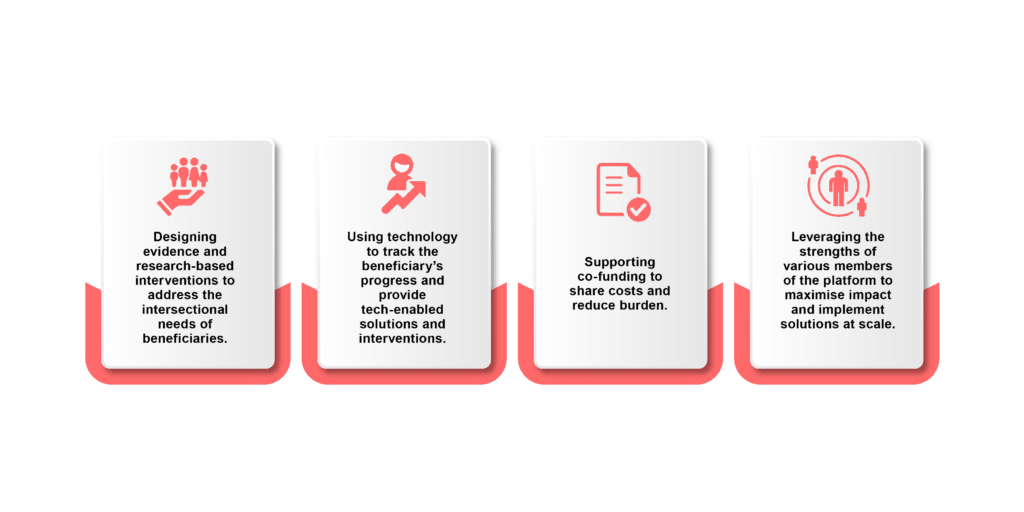
Our Achievements
Total Beneficiaries : 5.3 Million
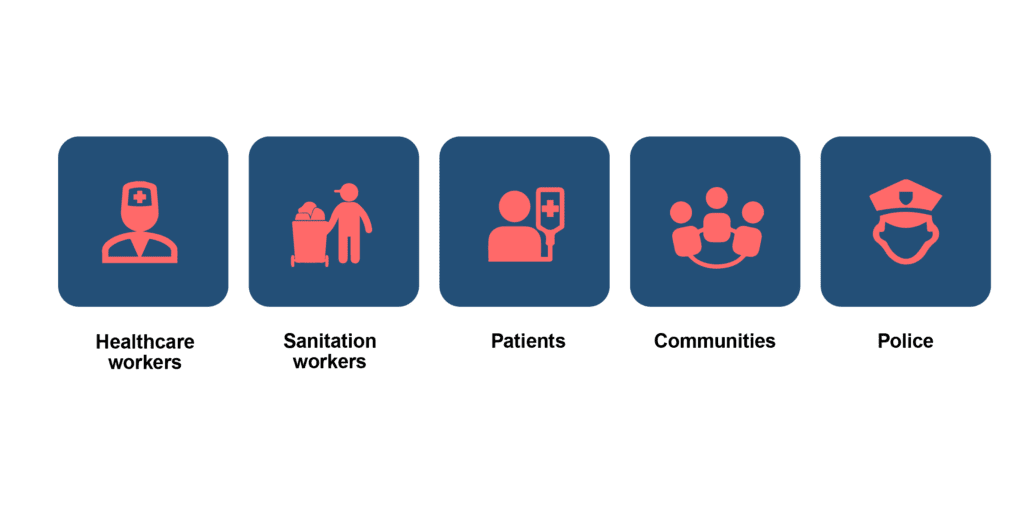
A) Healthcare Interventions
Strengthening the COVID-19 vaccination drive: We have inoculated over 3.02 million citizens in high-risk and remote areas across 99 districts in 19+ states through our COVID-19 vaccination drives.
Enabling access to critical care equipment & protective gear: Protective gears were supplied to frontline healthcare workers and police officers. Key medical equipment such as ECG machines and maternal monitors were also supplied for regular patients. 30 implementation partners helped supply this equipment across the country, thus helping us reach over 0.35 million people.
Addressing the medical oxygen crisis: In partnership with nine implementation partners, IPA procured and distributed 950 oxygen concentrators and set up four 500 LPM oxygen plants across the country. This helped impact over 0.3 million hospital patients across the country.
Training on COVID and non-COVID skills & knowledge: Through capacity building of healthcare workers and community awareness programs, we impacted nearly 0.13 million lives.
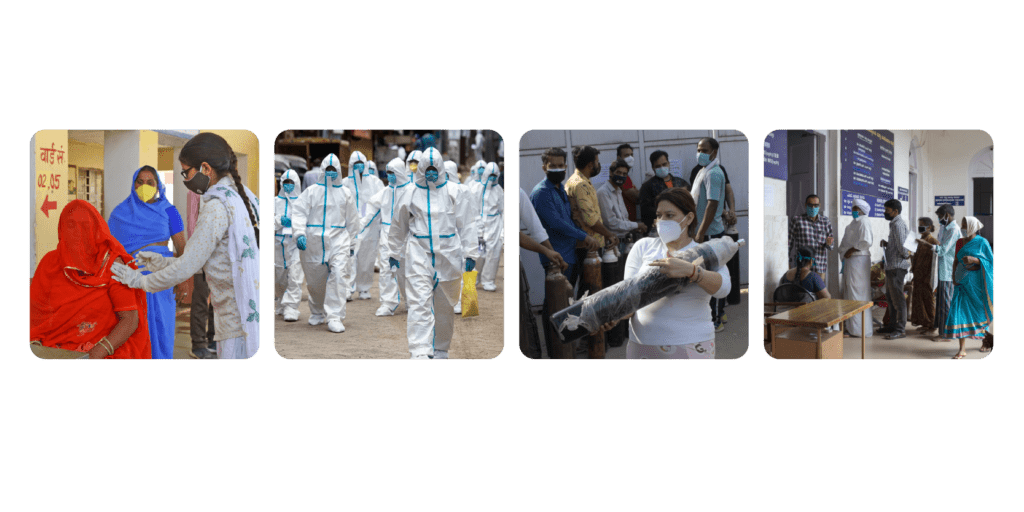
B) Sanitation Interventions
Strengthening community sanitation : Safe sanitation interventions were initiated across Maharashtra to build and improve access to sanitation infrastructures in schools and urban slum communities. Interventions were also planned for women working in informal workplaces. We impacted over 1.42 million lives.
Empowering sanitation workers: With focused sanitation safety, short-term relief and skilling, and entrepreneurial livelihood programs, the IPA has built the long-term resilience of more than 0.082 million sanitation workers.
Key Learnings & Takeaways
1. Collaboration across 59 funders and 52 implementation and knowledge partners quickly proved the potential of a collective impact that can be envisioned for any prospective project.
2. These learnings further underlined the need of building medium to long term infrastructural and training solutions to strengthen the health systems of India.
3. The importance of agility within organisations to take swift strategic decisions and act on them, especially during a crisis, plays a crucial role in effective and timely relief management.
4. Partnerships with the Government are critical and could unlock significant scale-up opportunities.
IPA’s Response to India’s second wave of COVID-19
IPA Supporting Public Institutions
#PehnoSahi – A corporate mask wearing initiative
Additionally, the Alliance collectively championed mask usage through an online campaign called #Pehnosahi. The campaign was shared by several industry leaders and Alliance members to urge their employees and networks to wear masks correctly for a safe back-to-work transition.
TESTIMONIALS
“The team at the India Protectors Alliance has impressed us with their national reach – from Maharashtra, to Delhi, to Kolkata – to support our frontline healthcare and sanitation workers during the COVID-19 crisis. Thanks to their guidance, our support for critical hospital equipment and PPE kits across these critical locations was executed in a timely, hassle-free manner.”
– Sandeep Batra – Chief Financial Officer, Crompton Greaves
“India Protectors Alliance was extremely helpful and effective in gathering the COVID-19 needs from our stakeholder communities. Its widespread implementation network and total commitment enabled us to expeditiously support the healthcare workers within these communities through the distribution of PPE kits.”
– Sudhanshu Vats – Chief Executive Officer, Essel Propack
DHFL|How to explore potential and unlock demographic advantage
DHFL|How to explore potential and unlock demographic advantage
DHFL wanted to invest their CSR funds in such a way that they can address critical gaps in 3 cause areas that can in turn help India unlock demographic advantages and explore the full potential of available resources. Read on to find out how they impacted over 150,000 lives.
The DHFL Story
Operating with a vision to engage in programs that can promote the enrichment of the society, DHFL first identified 3 cause areas and then worked with Samhita to curate or redesign programs that can address critical issues across the areas.
How to reap demographic advantages
Although India houses a high proportion of the world’s youth population, it has very few job opportunities and even fewer for those who are unskilled. Our research at the time indicated that the Indian government was able to train only 3.1 million of 12.8 million entrants into the workforce each year and needed private sector participation to address the gap.
Solution
We leveraged our research into corporate engagement in national skill development to design a skill program for youth within the Banking, Financial Services and Insurance (BFSI) and Construction sectors – that aligned to DHFL’s business goals.

Samhita managed the implementation of the program in 24 centres across 6 states. Inclusion of innovative components led us to receive recognition from the Associated Chambers of Commerce and Industry of India (ASSOCHAM), at their ASSOCHAM Summit-cum-Awards.
Geographies

Impact

How to ensure early-life development
DHFL was already supporting smaller and scattered interventions in education however a focused program was not yet curated. At the time a focus on Early Childhood Care and Education (ECCE) programs was the need of the hour.

Solution
We first undertook an assessment of the Anganwadis to understand specific needs of the target groups and gaps in ECCE. Then we curated a program that strengthened existing Anganwadi frameworks and ICDS schemes, and built capacities of the workers and helpers to become educators in Anganwadi centres. We also added a health and nutrition component to complement the education module and to ensure the sustained success of the program in the long run.
Geographies

Impact

How to tap into the society’s potential to transform
The water crisis is not new to India. Moreover, the unavailability of water can have a rippling effect on lives and livelihoods. Even in 2011, our research lended insights into how climate change and successive years of drought had resulted in immense ecological damage including soil erosion, lack of vegetation and reduction in crop yield by 70 per cent. In order to ensure holistic development, it was necessary to invest in water as an impact multiplier.
Solution
5 drought prone villages in Aurangabad were identified and adopted where climate change and successive years of drought had resulted in immense ecological damage. This severely hampered the ability of the villagers to support themselves and their dependents.To holistically address the damage, we took a 5-pronged approach.
Impact

Impact across the People-Planet-Profit (PPP) framework

Youth of India are trained to unlock job opportunities for them; Proper nourishment is ensured to women and young children to enable long-term health and survival; Holistic development of community is propelled by using water as an impact multiplier.

Community involvement prioritized to undertake water conservation and instill the component for the long term.

Supply of skilled personnel for the Banking, Financial Services and Insurance (BFSI) and Construction sectors – the primary
Kimberly Clark | Making lives better through purpose driven brands
Kimberly Clark | Making lives better through purpose driven brands
The global effort to achieve sanitation and water for all by 2030 is extending beyond the household to include institutional settings such as separate washrooms in schools and workspaces.
About 94% of women are employed in the informal sectors, according to the National Women’s Commission. Such informal sectors lack basic sanitation facilities including toilets. Public toilets, even if available, are often unsanitary and poorly maintained. Without access to toilets, women and girls develop coping strategies like drinking less water that in turn increases the risk for women’s health problems and their well-being, especially in times of menstruation. The extent of the problem is large in the school ecosystem across India

With the mission to create better workplaces that are healthier, safer and more productive, KCP in partnership with Samhita, designed two projects-
- Provide improved sanitation infrastructure in rural schools in Maharashtra and nudge children to adopt better sanitation habits
- Provide increased access to better sanitation facilities for women working in informal markets
How did we impact 2000+ women and children’s lives
Project 1- The project aimed at solving two key challenges-
- Poor usage of toilets by children in schools, and
- Absence of hand washing facilities at critical junctures
We collaborated with the Swachh Maharashtra Grand Challenge, a first-of-its-kind open innovation platform, in partnership with the government, corporate & social sector to address the key challenges in the sanitation ecosystem; by identifying and piloting innovative programme models across sanitation value chain. We identified 4 major components under this setup-

How to address the school sanitation ecosystem
Project 1 – The project aimed at solving two key challenges –
- Poor usage of toilets by children in schools, and
- Absence of hand washing facilities at critical junctures
We received 50+ innovative solutions from across the country. A thorough review of the applications led us to select the most innovative and sustainable programs that would help build an impactful ecosystem in school sanitation. KCP and Samhita together set the journey from selection to knowledge dissemination for the selected programs:
- Providing grants to selected pilot programmes
- Coaching & mentoring
- Project monitoring & evaluation, and
- Knowledge dissemination.

The project impacted 2000+ children of Chandrapur, Maharashtra.
How to help women access sanitation in informal markets
The second project aimed at addressing the need for safe sanitation facilities for women working in informal markets. We shortlisted GARV TOILETS and CORO as implementation partners. The project provides sanitation facilities with following features:

To provide holistic, effective and sustainable sanitation impact, four components were designed:
- Localised Behaviour Change Communication
- Menstrual Hygiene Management
- Operations & Maintenance
- Waste Management
To support the end-to-end implementation of the project, Samhita leveraged their in-house expertise through the following stages- providing operational plans, developing standard operating procedures, monitoring and evaluation progress and outcomes and providing capacity building support for the implementation partners.
The project impacted 2000+ women in Kurla, Mumbai, Maharashtra.
Geographies
Project 1: Chandrapur Maharashtra
Project 2: Kurla, Mumbai, Maharashtra
Impact Numbers
4000+ Lives Touched
VIACOM18 | How to impact through the media lens
VIACOM18 | How to impact through the media lens
In a time where majority stakeholders were concentrating on building infrastructure to achieve the mission of Swachh Bharat Abhiyan, Viacom18 utilized the weapon they knew best – storytelling to create lasting impact in a society that has long been captured by the screen.
The Viacom18 story
With the launch of Swachh Bharat Mission, availability and access to toilets had improved tremendously. But social and behavioural change communication were far from implementation questioning the long-term adoption of infrastructure usage. Lack of sanitation has many rippling effects.

The economic deprivation increases manifold when healthcare expenses and the cost of lost potential due to sickness arising from inadequate sanitation is added.
With the belief that sustained change in behaviour is at the helm of creating long term impact, Viacom18 worked with Samhita to design an intervention that aimed to address the issue of Open Defecation in Mumbai’s slums and inadequate sanitation in schools.
How did we impact 8,000+ lives
Samhita designed and implemented a community sanitation program with a focus on strong behaviour change in addition to providing basic infrastructure. Our theory of change centered around changing behavior, beliefs, and myths around toilets as a key to ensuring sustained open defecation free status in all communities and schools. The idea was to design visual messaging at key locations in slum areas, followed with awareness campaigns that brought together a social message with Viacom’s unique panache for storytelling.
Our vision of multiplying the impact by evolving the approach from infrastructure to behavioral change was distributed in 3 stages.

Geography

Impact


